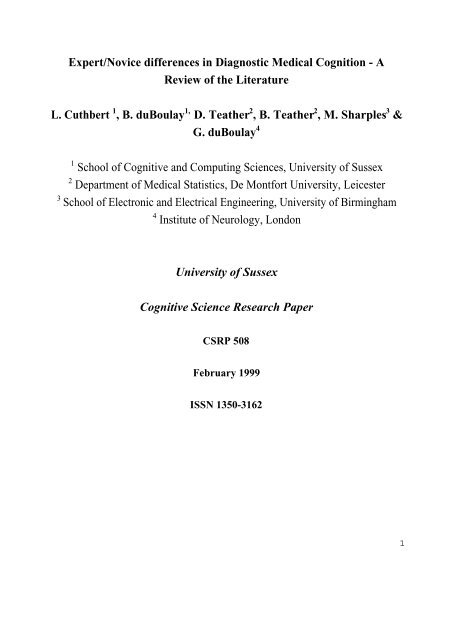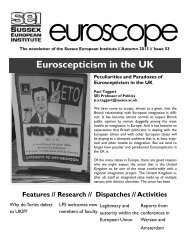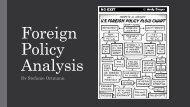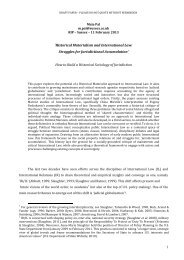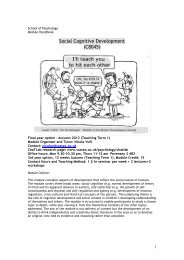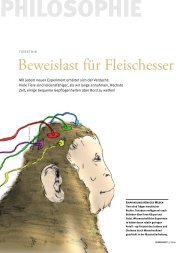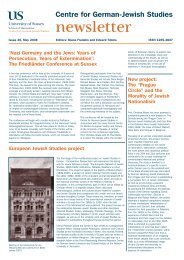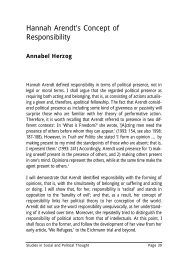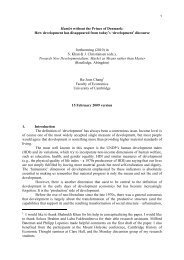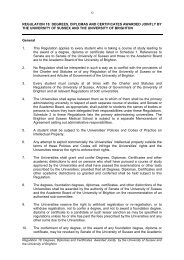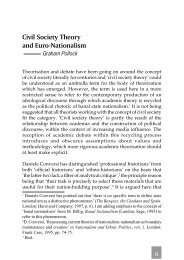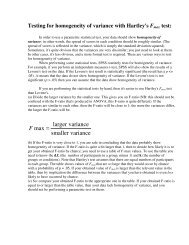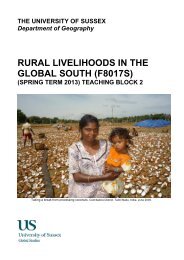Expert/Novice differences in Diagnostic Medical Cognition - A ...
Expert/Novice differences in Diagnostic Medical Cognition - A ...
Expert/Novice differences in Diagnostic Medical Cognition - A ...
Create successful ePaper yourself
Turn your PDF publications into a flip-book with our unique Google optimized e-Paper software.
<strong>Expert</strong>/<strong>Novice</strong> <strong>differences</strong> <strong>in</strong> <strong>Diagnostic</strong> <strong>Medical</strong> <strong>Cognition</strong> - A<br />
Review of the Literature<br />
L. Cuthbert 1 , B. duBoulay 1, D. Teather 2 , B. Teather 2 , M. Sharples 3 &<br />
G. duBoulay 4<br />
1 School of Cognitive and Comput<strong>in</strong>g Sciences, University of Sussex<br />
2 Department of <strong>Medical</strong> Statistics, De Montfort University, Leicester<br />
3<br />
School of Electronic and Electrical Eng<strong>in</strong>eer<strong>in</strong>g, University of Birm<strong>in</strong>gham<br />
4 Institute of Neurology, London<br />
University of Sussex<br />
Cognitive Science Research Paper<br />
CSRP 508<br />
February 1999<br />
ISSN 1350-3162<br />
1
Abstract: The nature of expertise has been studied <strong>in</strong> a wide variety of discipl<strong>in</strong>es. Many of these<br />
studies have found that the development of expertise <strong>in</strong>volves qualitative as well as quantitative<br />
changes <strong>in</strong> the cognitive skills and knowledge representations underly<strong>in</strong>g performance. This<br />
paper seeks to review the literature which has sought to identify expert/novice <strong>differences</strong> <strong>in</strong> the<br />
field of diagnostic medical cognition. This literature is concerned with the way experts and novices<br />
make diagnostic medical decisions. Differences are identified <strong>in</strong> terms of hypothesis generation<br />
and test<strong>in</strong>g, diagnostic reason<strong>in</strong>g and the organisation of relevant knowledge. Furthermore,<br />
expert's diagnostic reason<strong>in</strong>g is characterised as largely schema driven, with previous patient<br />
encounters <strong>in</strong>fluenc<strong>in</strong>g medical evaluations of current cases.<br />
<strong>Medical</strong> cognition refers to studies of cognitive processes (such as perception,<br />
comprehension, decision mak<strong>in</strong>g and problem solv<strong>in</strong>g) <strong>in</strong> medical practice. Studies have tended to<br />
concentrate on the decision mak<strong>in</strong>g processes and have tended to ignore other areas of medical<br />
expertise (such as patient management and report<strong>in</strong>g), and it should be acknowledged that this<br />
gives a rather narrow view of medical expertise. Studies of expertise <strong>in</strong> diagnostic medical<br />
cognition exam<strong>in</strong>e <strong>differences</strong> between practitioners with different levels of experience <strong>in</strong> terms of<br />
their cognitive processes and skills. Many of the studies (e.g. Patel, Arocha & Kaufman, 1994)<br />
dist<strong>in</strong>guish between novices (<strong>in</strong>dividuals who have only everyday knowledge of a doma<strong>in</strong> or the<br />
pre-requisite knowledge assumed by the doma<strong>in</strong>, i.e. medical students), <strong>in</strong>termediates (<strong>in</strong>dividuals<br />
who are above the beg<strong>in</strong>ner level but below the sub-expert level, for example, medical residents),<br />
sub-experts (<strong>in</strong>dividuals with generic knowledge but <strong>in</strong>adequate specialised knowledge of the<br />
doma<strong>in</strong>, for example, cardiology experts solv<strong>in</strong>g problems <strong>in</strong> the area of endocr<strong>in</strong>ology) and<br />
experts (an <strong>in</strong>dividual with specialised knowledge of the doma<strong>in</strong>, for example, cardiology experts<br />
solv<strong>in</strong>g cardiology problems). Some studies have broken these categories down even further, for<br />
example, by dist<strong>in</strong>guish<strong>in</strong>g between novices with different levels of experience (early,<br />
<strong>in</strong>termediate and advanced novices referr<strong>in</strong>g to 1st, 2nd and 3rd year students respectively -<br />
Arocha & Patel, 1995), or between basic-experts and super-experts (Raufaste, Eyrolle & Mar<strong>in</strong>e,<br />
1998). Super-experts refer to the top experts <strong>in</strong> a particular field.<br />
The aim of this paper is to provide a review of the literature exam<strong>in</strong><strong>in</strong>g expertise effects<br />
2
on diagnostic medical cognition. Generally speak<strong>in</strong>g, different studies have concentrated on<br />
different aspects of expertise effects on cognition, <strong>in</strong>clud<strong>in</strong>g hypothesis generation and<br />
evaluation, memory performance, diagnostic reason<strong>in</strong>g and the organisation of cl<strong>in</strong>ical knowledge.<br />
These issues will be dealt with <strong>in</strong>dependently <strong>in</strong> this paper. The paper also exam<strong>in</strong>es the more<br />
perceptually skilled discipl<strong>in</strong>e of radiology. Diagnosis <strong>in</strong> radiology <strong>in</strong>volves a two step process.<br />
First, the radiologists must perform a visual search of the radiograph to exam<strong>in</strong>e whether any<br />
abnormalities are present <strong>in</strong> the image. Second, if any abnormalities are identified by the scan,<br />
then the radiologist must further exam<strong>in</strong>e the areas of abnormality <strong>in</strong> order to perform a diagnosis.<br />
Hence, radiology can be seen as a perceptually skilled discipl<strong>in</strong>e. If abnormalities are missed <strong>in</strong><br />
the first scan of the image, then diagnosis may not be complete and accurate. We may therefore<br />
expect radiologists to possess different cognitive skills than experts specialis<strong>in</strong>g <strong>in</strong> doma<strong>in</strong>s of<br />
medic<strong>in</strong>e with a lesser visual component. This paper does not however concentrate on the visual<br />
perceptual skills per se of radiologists - <strong>in</strong>stead the emphasis is on the second stage, the<br />
diagnostic process itself, and on the <strong>in</strong>teraction between perception and problem solv<strong>in</strong>g.<br />
Most studies address<strong>in</strong>g the issue of expertise <strong>in</strong> medical cognition have tended to use the<br />
same basic experimental paradigm <strong>in</strong> which subjects are shown a written description of a cl<strong>in</strong>ical<br />
case (Patel & Groen, 1986, Patel, Groen & Arocha, 1990) and <strong>in</strong>structed to read the case notes<br />
for a specific period of time. The notes are then removed and the subject asked to recall details of<br />
the case and then to provide a diagnosis. In a variation of this paradigm, subjects are presented<br />
with the cl<strong>in</strong>ical <strong>in</strong>formation sequentially, one sentence at a time and asked to expla<strong>in</strong> the<br />
<strong>in</strong>com<strong>in</strong>g <strong>in</strong>formation and suggest a diagnosis. These methods are known as the immediate<br />
presentation paradigm and the sequential presentation paradigm respectively. The studies then<br />
use semantic, propositional and conceptual analysis techniques to characterise the structure of<br />
the subject's knowledge, to exam<strong>in</strong>e <strong>differences</strong> <strong>in</strong> problem representation and f<strong>in</strong>ally to evaluate<br />
levels of coherence <strong>in</strong> the subject's response (see Patel, Arocha & Kaufman (1994) for further<br />
detail). Th<strong>in</strong>k aloud <strong>in</strong>structions are also often <strong>in</strong>cluded. Some researchers have questioned the<br />
extent to which these rather artificial experimental tasks allow any valid conclusions to be drawn<br />
with regard to the nature of the diagnostic process. Patel, Evans & Kaufman (1989) moved away<br />
from the written cl<strong>in</strong>ical presentations and <strong>in</strong>stead exam<strong>in</strong>ed doctor/patient <strong>in</strong>terviews. <strong>Medical</strong><br />
practitioners were asked to <strong>in</strong>terview patients with the goal of develop<strong>in</strong>g a differential diagnosis.<br />
3
Patients were paid volunteer outpatients who had recently presented with the history and<br />
symptoms of an endocr<strong>in</strong>e disorder (the study required the diagnosis of an endocr<strong>in</strong>e disorder).<br />
The <strong>in</strong>terviews were conducted <strong>in</strong> actual sett<strong>in</strong>gs with realistic time constra<strong>in</strong>ts. Physicians were<br />
allowed to ask the patient any questions they liked <strong>in</strong> produc<strong>in</strong>g their diagnosis. Although this<br />
k<strong>in</strong>d of study can be seen as hav<strong>in</strong>g more ecological validity than the laboratory based studies<br />
discussed earlier, there is still an argument that even this type of study fails to capture the real<br />
processes undertaken <strong>in</strong> produc<strong>in</strong>g a diagnosis. Indeed, some researchers (e.g. Kle<strong>in</strong>, Calderwood<br />
& MacGregor, 1989, Huber, 1997) believe that <strong>in</strong> exam<strong>in</strong><strong>in</strong>g real world decisions a more<br />
naturalistic approach needs to be taken. Such an approach is based on the belief that real world<br />
decisions are <strong>in</strong>fluenced by the context <strong>in</strong> which they are made, study<strong>in</strong>g decisions outside their<br />
real world context is not a valid approach. Despite their limitations, laboratory studies of<br />
diagnostic medical cognition have produced some <strong>in</strong>terest<strong>in</strong>g results. The aim of this paper is to<br />
summarise and discuss these major f<strong>in</strong>d<strong>in</strong>gs.<br />
<strong>Expert</strong>ise effects<br />
One of the earliest stages <strong>in</strong> the diagnostic process <strong>in</strong>volves the formulation of work<strong>in</strong>g<br />
hypotheses. These are derived from cl<strong>in</strong>ical observations (<strong>in</strong> the form of signs, symptoms, test<br />
results, and results of physical exam<strong>in</strong>ations). The first section of the literature review exam<strong>in</strong>es<br />
the issue of the effects of expertise on hypothesis generation and evaluation.<br />
1. Hypothesis Generation & Evaluation.<br />
Sisson, Donnelly, Hess and Woolliscroft (1991) exam<strong>in</strong>ed how experts (with various<br />
different areas of sub-speciality with<strong>in</strong> Internal Medic<strong>in</strong>e) and novices (3rd year medical<br />
students) differ <strong>in</strong> terms of the number, specificity and breadth (range) of diagnostic hypotheses<br />
generated early <strong>in</strong> the evaluative process. They argue that these <strong>in</strong>itial hypotheses, although<br />
modified by subsequent data, will have a large <strong>in</strong>fluence on the diagnostic process. Their results<br />
showed that on average, the medical students generated more hypotheses than did the physicians,<br />
and this f<strong>in</strong>d<strong>in</strong>g was consistent across scenarios. Furthermore, physicians' hypotheses were<br />
found to be more general than the students; however, the two groups did not differ <strong>in</strong> terms of<br />
the breadth of their hypotheses (calculated as a percentage of possible categories of diagnosis).<br />
Neither group typically named all of the diagnostic categories that logically might have been<br />
4
<strong>in</strong>cluded as part of their hypotheses. Sisson et al. assume that the fact that physicians generate<br />
less specific hypotheses (<strong>in</strong> fact, their hypotheses were quite general) may reflect a consciously<br />
learned approach or an <strong>in</strong>tuitive evolution <strong>in</strong> reason<strong>in</strong>g. The problem with highly specific<br />
diagnoses based on limited data is that they may result <strong>in</strong> some form of premature closure, hence<br />
specific hypotheses can be seen as a pitfall that reduces the options available to lead to the<br />
proper diagnosis. A f<strong>in</strong>al, perhaps surpris<strong>in</strong>g f<strong>in</strong>d<strong>in</strong>g was that the numbers of hypotheses<br />
generated by the <strong>in</strong>dividual participants was fairly consistent across the three tasks studied.<br />
Other research suggests that the speed with which <strong>in</strong>itial hypotheses are generated is a strik<strong>in</strong>g<br />
feature of the behaviour of experts. Furthermore, there is evidence that the earlier a good<br />
hypothesis set is created, the more predictive it is of the quality of the diagnosis (Joseph & Patel,<br />
1990) .<br />
Lesgold, Rub<strong>in</strong>son, Feltovich, Glaser, Klopfer & Wang (1988) found that novice<br />
(resident) radiologists exam<strong>in</strong><strong>in</strong>g chest x-rays appear to restrict their responses to the most<br />
obvious explanation. Two hypotheses were put forward to expla<strong>in</strong> these f<strong>in</strong>d<strong>in</strong>gs: first, it may be<br />
that when there is a dom<strong>in</strong>ant hypothesis and a more remote possibility; consideration of the<br />
more remote possibility depends upon the availability of mental process<strong>in</strong>g capacity. If any<br />
subprocesses of diagnosis are <strong>in</strong>efficient they will <strong>in</strong>terfere with the more remote response. An<br />
alternative explanation is that novices simply do not generate the full range of sensible<br />
possibilities <strong>in</strong> forms that will survive test<strong>in</strong>g and verification. <strong>Novice</strong>s may have learned the<br />
trigger<strong>in</strong>g rule for the most obvious explanation but not for the subtle special cases. <strong>Novice</strong>s may<br />
fail because they have not yet developed the f<strong>in</strong>e-tuned visual acuity needed for feature<br />
discrim<strong>in</strong>ation that is seen <strong>in</strong> their more experienced colleagues.<br />
Patel, Arocha & Kaufman (1994), Joseph & Patel (1990) found that experts<br />
(endocr<strong>in</strong>ologists solv<strong>in</strong>g endocr<strong>in</strong>e problems) produce their hypotheses fairly quickly and<br />
accommodate subsequently presented data without <strong>in</strong>troduc<strong>in</strong>g any new hypotheses. In contrast,<br />
sub-experts (cardiologists solv<strong>in</strong>g endocr<strong>in</strong>e problems) cont<strong>in</strong>ue to generate new hypotheses even<br />
after produc<strong>in</strong>g most of the diagnostic components needed for the f<strong>in</strong>al diagnosis. They are less<br />
able to evaluate their hypotheses and hence show an <strong>in</strong>ability to rule out diagnostic hypotheses<br />
they had produced earlier. In general, the experts narrowed uncerta<strong>in</strong>ty whereas the sub-experts<br />
5
<strong>in</strong>creased it. They suggest that sub-experts do not have sufficient doma<strong>in</strong> knowledge to<br />
discrim<strong>in</strong>ate hypotheses. In contrast, experts' <strong>in</strong>itial hypothesis set appears to be particularly<br />
well constructed allow<strong>in</strong>g them to complete the diagnostic task from the hypotheses conta<strong>in</strong>ed <strong>in</strong><br />
the orig<strong>in</strong>al set without add<strong>in</strong>g new hypotheses.<br />
Arocha & Patel (1995) exam<strong>in</strong>ed the effects of <strong>in</strong>consistent data on subjects' hypotheses<br />
generation and evaluation. Early, <strong>in</strong>termediate and advanced novices (2nd, 3rd & 4th year medical<br />
students) showed <strong>differences</strong> <strong>in</strong> terms of their use of co-ord<strong>in</strong>at<strong>in</strong>g operations. These are<br />
responses to <strong>in</strong>consistent data that are commonly used <strong>in</strong> scientific and everyday reason<strong>in</strong>g and<br />
<strong>in</strong>clude; ignor<strong>in</strong>g data, exclud<strong>in</strong>g data, re-<strong>in</strong>terpret<strong>in</strong>g data, re-<strong>in</strong>terpret<strong>in</strong>g hypothesis, modify<strong>in</strong>g a<br />
hypothesis to fit the data, and chang<strong>in</strong>g a hypothesis altogether. Early and <strong>in</strong>termediate novices<br />
performed more data operations and they more frequently ignored or re<strong>in</strong>terpreted <strong>in</strong>consistent<br />
data, whereas advanced novices more often changed their hypotheses to account for the data,<br />
changes which decreased the <strong>in</strong>consistency with the data. Advanced novices generated a number<br />
of early hypotheses and this allowed them to narrow their <strong>in</strong>itial hypothesis set <strong>in</strong> the face of<br />
<strong>in</strong>consistent evidence and make fewer data re<strong>in</strong>terpretations. Intermediates also generated a<br />
number of early hypotheses, however they failed to change their hypotheses when confronted<br />
with <strong>in</strong>consistent data. Instead they ma<strong>in</strong>ta<strong>in</strong>ed several hypotheses of a diverse nature<br />
concurrently without evaluat<strong>in</strong>g them efficiently. Arocha & Patel concluded that tra<strong>in</strong><strong>in</strong>g appears<br />
to make novices more sensitive to what their data tells them.<br />
Raufaste, Eyrolle & Mar<strong>in</strong>e (1998) were concerned with how the generation of pert<strong>in</strong>ent<br />
hypotheses may be related to expertise <strong>in</strong> radiological diagnosis (experts are known to be<br />
particularly adept at produc<strong>in</strong>g pert<strong>in</strong>ent hypotheses rapidly). They use a model of spread<strong>in</strong>g<br />
activation with<strong>in</strong> semantic networks to expla<strong>in</strong> how experts produce more pert<strong>in</strong>ent diagnostic<br />
hypotheses. In particular, pert<strong>in</strong>ence is hypothesised to orig<strong>in</strong>ate from the <strong>in</strong>terrelations between<br />
the elements <strong>in</strong> the semantic networks - the more schema are l<strong>in</strong>ked together, the more pert<strong>in</strong>ence<br />
will be demonstrated because pert<strong>in</strong>ent schema will receive multiple primes and then receive more<br />
activation. To test this hypothesis the authors exam<strong>in</strong>ed the semantic networks of novices,<br />
<strong>in</strong>termediates, basic experts and super-experts (top specialists) diagnos<strong>in</strong>g two difficult chest x-<br />
rays. As expected, a significant correlation between <strong>in</strong>tegration and pert<strong>in</strong>ence was obta<strong>in</strong>ed - and<br />
6
this relationship could not be expla<strong>in</strong>ed <strong>in</strong> terms of experience. However it seems that this was<br />
not the full story. Whilst <strong>in</strong>termediates and basic-experts could not be dist<strong>in</strong>guished <strong>in</strong> terms of<br />
the pert<strong>in</strong>ence of their diagnostic hypotheses, super-experts showed a higher level of pert<strong>in</strong>ence<br />
than these other two groups, and furthermore the relationship between pert<strong>in</strong>ence and <strong>in</strong>tegration<br />
disappeared for these subjects. Hence, at this level of performance, an alternative explanation for<br />
pert<strong>in</strong>ence must be found. They suggest that <strong>in</strong> typical cases (the type likely to be seen by<br />
<strong>in</strong>termediates and basic-experts alike), spread<strong>in</strong>g activation would be sufficient to allow the<br />
retrieval of pert<strong>in</strong>ent hypotheses. However, for less typical cases, process<strong>in</strong>g would become<br />
unconstra<strong>in</strong>ed. In such cases, only the super-experts who ma<strong>in</strong>ta<strong>in</strong> deliberate reason<strong>in</strong>g activity <strong>in</strong><br />
their everyday work (through their research <strong>in</strong>terests and diagnos<strong>in</strong>g unusual cases) would trigger<br />
sufficient levels of deliberate reason<strong>in</strong>g - the k<strong>in</strong>d necessary to constra<strong>in</strong> possibilities optimally <strong>in</strong><br />
such cases. Such a hypothesis is consistent with Ericsson, Krampe & Tesch-Romer's (1993)<br />
view that 'em<strong>in</strong>ent performance' is directly related to the 'amount of deliberate practice related to<br />
that goal'. Interest<strong>in</strong>gly, the authors also found that the richness of the semantic networks<br />
underly<strong>in</strong>g problem solv<strong>in</strong>g was better able to expla<strong>in</strong> diagnostic success than years of experience.<br />
Another important area of research has exam<strong>in</strong>ed the effects of expertise on the<br />
directionality of reason<strong>in</strong>g employed. This refers to the dist<strong>in</strong>ction between forward reason<strong>in</strong>g (<strong>in</strong><br />
which the physician attempts to generate a hypothesis from the f<strong>in</strong>d<strong>in</strong>gs <strong>in</strong> a case) and backward<br />
reason<strong>in</strong>g (<strong>in</strong> which the data collection is <strong>in</strong>fluenced by the hypothesis generated). Patel & Groen<br />
(1986) found that directionality of reason<strong>in</strong>g is related to diagnostic accuracy. They found that<br />
the diagnostic explanations of subjects mak<strong>in</strong>g an accurate diagnoses (of acute bacterial<br />
endocarditis) consisted of pure forward reason<strong>in</strong>g. In contrast, subjects with <strong>in</strong>accurate diagnoses<br />
tended to make use of forward and backward reason<strong>in</strong>g. Subsequent studies have confirmed this<br />
relationship between diagnostic accuracy and forward reason<strong>in</strong>g. Patel, Groen & Arocha (1990)<br />
exam<strong>in</strong>ed factors which may disrupt this pattern of forward reason<strong>in</strong>g. They exam<strong>in</strong>ed the<br />
reason<strong>in</strong>g strategies used by expert cardiologists and endocr<strong>in</strong>ologists solv<strong>in</strong>g problems with<strong>in</strong> or<br />
outside their area of expertise. They found that an accurate diagnosis (usually from the experts)<br />
was associated with pure forward reason<strong>in</strong>g <strong>in</strong> the production of an explanation of the pr<strong>in</strong>ciple<br />
component of the diagnosis. However, this was often accompanied by one or two components of<br />
backward reason<strong>in</strong>g to expla<strong>in</strong> any loose ends. In contrast, <strong>in</strong>accurate diagnoses (usually from the<br />
7
sub-experts) were associated with the use of both forward and backwards reason<strong>in</strong>g. Accord<strong>in</strong>g<br />
to Patel & Groen (1991), it is important to dist<strong>in</strong>guish between experts' use of backward<br />
reason<strong>in</strong>g (where it is used to tie up loose ends) and that of less experienced physicians. The<br />
dist<strong>in</strong>ction between forward and backward reason<strong>in</strong>g is closely related to the dist<strong>in</strong>ction between<br />
strong-problem solv<strong>in</strong>g methods (which are highly constra<strong>in</strong>ed by the problem solv<strong>in</strong>g<br />
environment) and weak methods (which are only m<strong>in</strong>imally constra<strong>in</strong>ed). However the two are<br />
logically <strong>in</strong>dependent. Forward reason<strong>in</strong>g is highly error prone <strong>in</strong> the absence of adequate doma<strong>in</strong><br />
knowledge as there are no built-<strong>in</strong> checks of legitimacy (a great deal of knowledge is needed to use<br />
forward reason<strong>in</strong>g successfully, hence to all <strong>in</strong>tents and purposes it is a strong method).<br />
Backward reason<strong>in</strong>g is best used when doma<strong>in</strong> knowledge is <strong>in</strong>adequate, as reason<strong>in</strong>g will be<br />
m<strong>in</strong>imally hampered by this lack of knowledge. A weak method is preferable when (as is likely<br />
with anyone but an expert) relevant prior knowledge is lack<strong>in</strong>g. Patel & Groen (1991) classify<br />
experts' use of backwards reason<strong>in</strong>g (to tie up loose ends) as a strong method, this is important as<br />
the use of backward reason<strong>in</strong>g is usually associated with the use of weak methods. Lesgold<br />
(1988) found evidence that radiological diagnosis is neither primarily top-down (backward<br />
reason<strong>in</strong>g) not bottom-up (forward reason<strong>in</strong>g), <strong>in</strong>stead process<strong>in</strong>g is seen as a comb<strong>in</strong>ation of the<br />
two, <strong>in</strong>corporat<strong>in</strong>g features of both models <strong>in</strong> a recursive, <strong>in</strong>teractive decision mak<strong>in</strong>g process.<br />
Arocha, Patel & Patel (1993) found <strong>differences</strong> between novices (medical students) with<br />
different levels of expertise. Early novices use a strategy similar to depth first search, consider<strong>in</strong>g<br />
and evaluat<strong>in</strong>g a s<strong>in</strong>gle hypothesis at a time, furthermore they demonstrate a tendency to<br />
ma<strong>in</strong>ta<strong>in</strong> hypotheses despite contradictory evidence. Intermediate and advanced novices use a<br />
form of breadth first search as they consider and evaluate several hypotheses concurrently.<br />
However, <strong>differences</strong> between <strong>in</strong>termediates and advanced novices were found, <strong>in</strong> that<br />
<strong>in</strong>termediates were less skilled at evaluat<strong>in</strong>g hypotheses, and hence tended to ma<strong>in</strong>ta<strong>in</strong> several<br />
hypotheses for long periods of time without resolv<strong>in</strong>g or elim<strong>in</strong>at<strong>in</strong>g them. Intermediates also<br />
showed a tendency to generate several diagnostic hypotheses to account for different f<strong>in</strong>d<strong>in</strong>gs. In<br />
contrast, advanced novices generated multiple hypotheses to account for the same set of f<strong>in</strong>d<strong>in</strong>gs.<br />
The net result is less irrelevant search compared to the <strong>in</strong>termediates. Breadth first search has<br />
been associated <strong>in</strong> other areas of reason<strong>in</strong>g (e.g. scientific reason<strong>in</strong>g - Klahr & Dunbar, 1988) with<br />
problem solv<strong>in</strong>g success.<br />
8
Evans & Gadd (1989) describe four different levels <strong>in</strong>to which cl<strong>in</strong>ical knowledge is<br />
organised <strong>in</strong> a medical problem solv<strong>in</strong>g context. Observations are units of <strong>in</strong>formation that are<br />
recognised as potentially relevant <strong>in</strong> a problem solv<strong>in</strong>g context, however they do not constitute<br />
cl<strong>in</strong>ically useful facts. F<strong>in</strong>d<strong>in</strong>gs are observations that have potential cl<strong>in</strong>ical significance (e.g.<br />
symptoms). Facets are clusters of f<strong>in</strong>d<strong>in</strong>gs that are suggestive of pre-diagnostic <strong>in</strong>terpretations.<br />
They reflect general pathological descriptions such as aortic <strong>in</strong>sufficiency, or categorical<br />
descriptions such as endocr<strong>in</strong>e problem. They are also <strong>in</strong>terim hypotheses that divide the<br />
<strong>in</strong>formation <strong>in</strong> the problem <strong>in</strong>to manageable sub-problems and suggest possible solutions. Facets<br />
vary <strong>in</strong> their level of abstraction - from high level facets which may partition the problem space<br />
and may be a reasonable approximation to a candidate solution - to low level facets which may<br />
<strong>in</strong>volve a more local <strong>in</strong>ference that may expla<strong>in</strong> one or two f<strong>in</strong>d<strong>in</strong>gs and would not advance the<br />
problem solv<strong>in</strong>g process to the same extent. Diagnosis is the level of classification that<br />
encompasses and expla<strong>in</strong>s all levels beneath it. The model is hierarchical with facets and<br />
diagnoses serv<strong>in</strong>g both to establish a context <strong>in</strong> which observations and f<strong>in</strong>d<strong>in</strong>gs are <strong>in</strong>terpreted,<br />
and to provide a basis for anticipat<strong>in</strong>g and search<strong>in</strong>g for confirm<strong>in</strong>g or discrim<strong>in</strong>at<strong>in</strong>g f<strong>in</strong>d<strong>in</strong>gs.<br />
Arocha & Patel (1995) found that whilst all early and most <strong>in</strong>termediate novices generated<br />
hypotheses at the diagnostic level, most advanced novices generated hypotheses at the facet<br />
level. Facet-level hypotheses typically describe general categories of disease with similar<br />
underly<strong>in</strong>g processes. Patel, Arocha & Kaufman (1994) found that expert physicians work<strong>in</strong>g<br />
with<strong>in</strong> their doma<strong>in</strong> of expertise (cardiologists solv<strong>in</strong>g cardiology problems) generate hypotheses<br />
<strong>in</strong> the form of high level facets. This serves to partition the problem <strong>in</strong>to manageable units, thus<br />
reduc<strong>in</strong>g the load on work<strong>in</strong>g memory. In contrast, sub-experts (endocr<strong>in</strong>ologists solv<strong>in</strong>g<br />
cardiology problems) generated hypotheses mostly at the low-level facet, with some high level<br />
facets and diagnostic hypotheses.<br />
Patel, Arocha & Kaufman (1994) proposed that a facet can be construed as a retrieval<br />
structure that can be used to access rapidly schema from long-term memory (LTM) and to<br />
partition a medical problem <strong>in</strong>to manageable units to facilitate the production of a diagnostic<br />
hypothesis. This hypothesis has parallels with skilled memory theory, which assumes that at the<br />
9
time of encod<strong>in</strong>g, experts acquire a set of retrieval cues that are associated <strong>in</strong> a functional manner<br />
with the <strong>in</strong>formation to be stored <strong>in</strong> memory (Ericsson, Krampe & Tesch-Romer, 1993). In a<br />
problem solv<strong>in</strong>g situation, an expert can use these retrieval structures to provide selective and<br />
rapid access to long-term memory.<br />
Another strand of research has exam<strong>in</strong>ed memory performance as a measure of expertise.<br />
Indeed, there is a long tradition expand<strong>in</strong>g over three decades of us<strong>in</strong>g memory measures to<br />
exam<strong>in</strong>e expertise <strong>in</strong> other discipl<strong>in</strong>es. For example, de Groot (1965) and Chase & Simon (1973)<br />
both used recall of mid-game chess positions follow<strong>in</strong>g brief exposure to the board (approx 5<br />
secs) and found that experts are typically able to recall about 90% of the positions of the pieces<br />
accurately, as long as the positions are legal. With random positions the experts do not perform<br />
any better than novices. These k<strong>in</strong>ds of f<strong>in</strong>d<strong>in</strong>gs have been replicated with experts <strong>in</strong> other fields,<br />
<strong>in</strong>clud<strong>in</strong>g computer programm<strong>in</strong>g (Adelson 1984) and bridge (Charness, 1979). Superior memory<br />
for the doma<strong>in</strong> is thought to result from <strong>differences</strong> <strong>in</strong> the amount of <strong>in</strong>formation encoded.<br />
Specifically, experts are assumed to encode <strong>in</strong>formation <strong>in</strong> larger, more doma<strong>in</strong> structured chunks<br />
than novices.<br />
2. Memory performance as a measure of medical expertise.<br />
Several studies have exam<strong>in</strong>ed the effects of medical expertise on recall performance with<br />
the expectation of demonstrat<strong>in</strong>g the usual expert/novice <strong>differences</strong>. Muzz<strong>in</strong>, Norman, Jacoby,<br />
Freightner, Tugwell & Guyatt (1982, 1983) found that whilst cl<strong>in</strong>icians faced with a written<br />
description of a patient's problem processed <strong>in</strong>formation more rapidly and <strong>in</strong> larger chunks than<br />
novices, they recalled fewer chunks. Hence there was no overall difference <strong>in</strong> recall. Groen &<br />
Patel (1985) suggested that the failure to f<strong>in</strong>d <strong>differences</strong> between novices and experts may be<br />
due to the use of analytic methods which are too simplistic. In their studies they used<br />
propositional analysis to exam<strong>in</strong>e memory performance. Propositional analysis segments the<br />
orig<strong>in</strong>al text <strong>in</strong>to <strong>in</strong>dividual propositions correspond<strong>in</strong>g to the discrete idea units <strong>in</strong> the text. A<br />
similar analysis is carried out on the transcripts recalled by each subject. Hence, propositional<br />
analysis is more concerned with the overlap between the underly<strong>in</strong>g mean<strong>in</strong>g of the orig<strong>in</strong>al and<br />
recalled text than with verbatim recall per se. Despite this change <strong>in</strong> analytic methods, Patel and<br />
her colleagues have failed to f<strong>in</strong>d any consistent effects of expertise on memory (e.g. Coughl<strong>in</strong> &<br />
10
Patel, 1987, Patel, Groen & Fredicson, 1986). To expla<strong>in</strong> these <strong>differences</strong> from non-medical<br />
doma<strong>in</strong>s, Norman, Brooks & Allen (1989) po<strong>in</strong>t to <strong>differences</strong> <strong>in</strong> the nature of the tasks between<br />
the highly visual, automatic process<strong>in</strong>g required <strong>in</strong> chess or bridge, and the much more deliberate,<br />
conscious process<strong>in</strong>g of medical <strong>in</strong>formation. Patel & Groen (1986) also found no <strong>differences</strong><br />
between experts (cardiologists solv<strong>in</strong>g a cardiology task) and sub-experts (surgeons and<br />
psychiatrists solv<strong>in</strong>g cardiology problems) <strong>in</strong> terms of recall. This was true for both relevant and<br />
irrelevant propositions. Patel, Arocha & Kaufman (1994) replicated this f<strong>in</strong>d<strong>in</strong>g, furthermore, a<br />
ceil<strong>in</strong>g effect was found for relevant material. They suggest that recall measures do not<br />
discrim<strong>in</strong>ate at this level of expertise.<br />
Norman et al. (1989) exam<strong>in</strong>ed the effects of memory test procedure on expertise effects.<br />
In particular, they exam<strong>in</strong>ed the hypothesis that expertise effects may be more likely to arise<br />
when subjects are not aware of the fact that their memory for the cases is to be tested. The<br />
<strong>in</strong>cidental memory test condition required subjects to recall case <strong>in</strong>formation (laboratory data)<br />
after they had provided a diagnosis. They found that the medical students (3rd years) recalled<br />
nearly twice as much <strong>in</strong>formation <strong>in</strong> the <strong>in</strong>tentional condition whilst the experts' (nephrologists &<br />
respirologists) recall was superior <strong>in</strong> the <strong>in</strong>cidental condition. Overall, experts recalled more data<br />
than the novices, however, this effect was far stronger <strong>in</strong> the <strong>in</strong>cidental condition. <strong>Expert</strong>s and<br />
novices both recalled more critical and abnormal data than non-critical and normal data, however<br />
the experts recalled more non-critical data than the novices. They suggest that this may be<br />
because hav<strong>in</strong>g produced a solution, the experts devote more resources to ensur<strong>in</strong>g that this<br />
explanation is consistent with the rest of the data present <strong>in</strong> the case. <strong>Expert</strong>s appear to deal with<br />
more pieces of <strong>in</strong>formation, as supported by the f<strong>in</strong>d<strong>in</strong>g that they mention nearly twice as much<br />
data <strong>in</strong> describ<strong>in</strong>g the case. Hence, expertise effects on memory have been demonstrated, however<br />
these are stronger when subjects are unaware that their memory is to be tested.<br />
The <strong>in</strong>termediate effect <strong>in</strong> recall refers to the f<strong>in</strong>d<strong>in</strong>g that <strong>in</strong>termediates perform better on<br />
memory tasks than either experts or novices (Patel & Groen, 1991, Schmidt & Boshuizen, 1993).<br />
Patel and Groen also found that whilst <strong>in</strong>termediates operated on both high and low relevance<br />
<strong>in</strong>formation show<strong>in</strong>g an <strong>in</strong>ability to discrim<strong>in</strong>ate, experts operated more on highly relevant<br />
<strong>in</strong>formation. Taken together, these f<strong>in</strong>d<strong>in</strong>gs suggest that outcome measures emphasis<strong>in</strong>g recall are<br />
11
not accurate <strong>in</strong>dices of underly<strong>in</strong>g knowledge and do not measure effective use of knowledge.<br />
Recall is nonmonotonically related to expertise, with <strong>in</strong>termediates recall<strong>in</strong>g more than experts or<br />
novices. Schmidt & Boshuizen (1993) found that the <strong>in</strong>termediate effect <strong>in</strong> recall disappears if<br />
short exposure times are used (30 secs). They suggest that under such restricted conditions,<br />
<strong>in</strong>termediates cannot engage <strong>in</strong> extraneous search and this affects their recall performance, i.e.<br />
they suggest that <strong>in</strong>termediates process too much 'garbage' - <strong>in</strong>formation that experts ignore.<br />
So far, this review has concentrated upon the hypothesis generation, evaluation and<br />
memory skills of <strong>in</strong>dividuals with different levels of medical expertise. A third area of research<br />
has exam<strong>in</strong>ed diagnostic reason<strong>in</strong>g skills - the process by which experts and novices draw<br />
diagnostic conclusions regard<strong>in</strong>g the nature of a compla<strong>in</strong>t.<br />
3. <strong>Diagnostic</strong> Reason<strong>in</strong>g.<br />
Joseph & Patel (1990) found that both experts (endocr<strong>in</strong>ologists solv<strong>in</strong>g endocr<strong>in</strong>e cases)<br />
and sub-experts (cardiologists solv<strong>in</strong>g endocr<strong>in</strong>e cases) selected more relevant and critical cues<br />
than irrelevant cues from a case history. However, experts were better able to focus on the critical<br />
and relevant <strong>in</strong>formation than sub-experts. <strong>Expert</strong>s also generated more l<strong>in</strong>ks to relate critical or<br />
relevant cues, show<strong>in</strong>g better organisation of their doma<strong>in</strong> knowledge. Similar f<strong>in</strong>d<strong>in</strong>gs have been<br />
obta<strong>in</strong>ed <strong>in</strong> radiology. Lesgold et al. (1988) found that experts reported more different f<strong>in</strong>d<strong>in</strong>gs,<br />
had longer reason<strong>in</strong>g cha<strong>in</strong>s, larger and more clusters, and a greater number of their f<strong>in</strong>d<strong>in</strong>gs<br />
connected to at least one other f<strong>in</strong>d<strong>in</strong>g. Hence experts differ from novices <strong>in</strong> terms of the<br />
coherence of their knowledge and explanations.<br />
As expected, on most tasks experts show superior diagnostic performance <strong>in</strong> classify<strong>in</strong>g<br />
cl<strong>in</strong>ical conditions. Furthermore, there is evidence to suggest that the superior diagnostic skills of<br />
experts may be due to their ability to fully utilise patient <strong>in</strong>formation presented <strong>in</strong> cl<strong>in</strong>ical<br />
protocols (known as enabl<strong>in</strong>g conditions). Schmidt, Hobus, Patel & Boshuizen (1987) found that<br />
when expert family doctors were presented with slides conta<strong>in</strong><strong>in</strong>g a picture of the patient<br />
(allow<strong>in</strong>g them to deduce the subjects age, sex etc), and <strong>in</strong>formation about the patients<br />
profession, previous diseases, medication, marital status and so forth, then they showed superior<br />
diagnostic skills (compared to novice family doctors) when they were subsequently presented<br />
12
with the patient's compla<strong>in</strong>t (38% vs. 27%). They suggest that this may be due to differential use<br />
of enabl<strong>in</strong>g conditions <strong>in</strong>formation as the experts remembered 40% more of this <strong>in</strong>formation.<br />
Hobus, Hofstra, Boshuizen & Schmidt (1989) found that when <strong>in</strong>formation about enabl<strong>in</strong>g<br />
conditions was not presented to expert physicians, their diagnostic performance was no better<br />
than that of novice physicians. They also found that when experts were asked to describe typical<br />
patients with certa<strong>in</strong> diseases, they gave richer descriptions, <strong>in</strong> particular with reference to the<br />
contextual factors facilitat<strong>in</strong>g the emergence of the disease.<br />
Similar f<strong>in</strong>d<strong>in</strong>gs have been obta<strong>in</strong>ed with experts <strong>in</strong> radiology. Norman, Brooks, Coblentz<br />
& Babcook (1992) exam<strong>in</strong>ed the effects of <strong>in</strong>formation conta<strong>in</strong>ed <strong>in</strong> a brief cl<strong>in</strong>ical history on<br />
diagnosis and on feature identification from radiographs. They were concerned with the diagnosis<br />
of bronchilitis, and a bronchilitis history (fever, cough and tachypnea) was <strong>in</strong>duced for some<br />
trials. Hav<strong>in</strong>g been presented with the case, paediatric radiologists were asked to rate the<br />
likelihood of bronchilitis on a scale from -3 for def<strong>in</strong>itely absent to +3 for def<strong>in</strong>itely present.<br />
Feature history was found to affect both diagnosis (with a change <strong>in</strong> the scale of between one half<br />
and one unit on the scale), and feature identification (the effect amounted to an <strong>in</strong>crease of about<br />
25%-50% <strong>in</strong> the number of features identified on film). Furthermore, no novice-expert <strong>differences</strong><br />
were found <strong>in</strong> terms of the rat<strong>in</strong>gs of likelihood of bronchilitis, however, a small significant effect<br />
of expertise was found <strong>in</strong> feature identification with novices report<strong>in</strong>g more features than experts.<br />
They concluded that both experts and novices were equally susceptible to <strong>in</strong>fluence from a<br />
history. Hence it seems that experience acquired <strong>in</strong> the normal course of practice is <strong>in</strong>sufficient to<br />
avoid such effects.<br />
There is also evidence to suggest that experts and novices differ <strong>in</strong> their use of biomedical<br />
knowledge <strong>in</strong> mak<strong>in</strong>g a diagnosis. In particular, f<strong>in</strong>d<strong>in</strong>gs from studies where subjects are required<br />
to th<strong>in</strong>k aloud whilst mak<strong>in</strong>g a diagnosis suggest that experts rarely refer to pathophysiological<br />
concepts whilst reason<strong>in</strong>g about a case, however students use pathophysiological concepts<br />
extensively (Boshuizen, Schmidt & Coughl<strong>in</strong> 1988, Patel, Evans & Groen, 1988). Patel, Groen &<br />
Arocha (1994) found that whilst experts (endocr<strong>in</strong>ologists solv<strong>in</strong>g endocr<strong>in</strong>e problems) do not<br />
use detailed biomedical knowledge <strong>in</strong> solv<strong>in</strong>g rout<strong>in</strong>e cl<strong>in</strong>ical problems <strong>in</strong> their own doma<strong>in</strong> of<br />
13
expertise, they do use it if they are solv<strong>in</strong>g either a difficult problem or a problem outside their<br />
doma<strong>in</strong> of expertise (cardiologists solv<strong>in</strong>g endocr<strong>in</strong>e problems). Boshuizen and Schmidt (1992)<br />
exam<strong>in</strong>e three possible explanations for these expert/novice <strong>differences</strong>. Firstly, it may be that<br />
after a certa<strong>in</strong> amount of time <strong>in</strong> the development of expertise, biomedical knowledge becomes<br />
rudimentary; with detailed knowledge no longer retrievable. Alternatively, biomedical knowledge<br />
may become <strong>in</strong>ert; that is, it is still available to medical experts and can be activated when directly<br />
addressed, but is not used <strong>in</strong> diagnostic reason<strong>in</strong>g; cl<strong>in</strong>ical knowledge is applied <strong>in</strong>stead. The f<strong>in</strong>al<br />
alternative is that biomedical knowledge may become encapsulated and is <strong>in</strong>tegrated <strong>in</strong> cl<strong>in</strong>ical<br />
knowledge. Accord<strong>in</strong>g to this hypothesis, experts apply encapsulated knowledge which is<br />
associated with detailed, deep level, knowledge which can be retrieved as necessary. Their own<br />
evidence supported the encapsulation hypothesis, experts showed <strong>in</strong>creased l<strong>in</strong>kage between<br />
concepts used <strong>in</strong> the th<strong>in</strong>k-aloud protocols and the post hoc explanations. They concluded that<br />
experts use biomedical knowledge <strong>in</strong> a tacit way, because <strong>in</strong> the course of becom<strong>in</strong>g an expert this<br />
type of causal knowledge becomes encapsulated <strong>in</strong>to cl<strong>in</strong>ical concepts.<br />
Accord<strong>in</strong>g to Gale & Marsden (1983) when students and cl<strong>in</strong>icians are presented with<br />
cl<strong>in</strong>ical <strong>in</strong>formation they <strong>in</strong>terpret it by identify<strong>in</strong>g for themselves personally important pieces of<br />
<strong>in</strong>formation called 'forceful features'. These act as a key to particular memory structures which <strong>in</strong><br />
turn give rise to cl<strong>in</strong>ical <strong>in</strong>terpretation. They exam<strong>in</strong>ed experts and novices' diagnostic reason<strong>in</strong>g<br />
by present<strong>in</strong>g them with cases and ask<strong>in</strong>g them to give up to five ideas as to what may be wrong<br />
with patients and furthermore, to identify the item of <strong>in</strong>formation (forceful feature) which gave<br />
rise to these <strong>in</strong>terpretations. They failed to f<strong>in</strong>d any <strong>differences</strong> between experts (registrars and<br />
consultants <strong>in</strong> general medic<strong>in</strong>e) and novices (1st & 3rd year medical students) <strong>in</strong> terms of the<br />
number of <strong>in</strong>terpretations provided, and this f<strong>in</strong>d<strong>in</strong>g lead them to conclude that level of cl<strong>in</strong>ical<br />
experience does not affect the number of <strong>in</strong>terpretations made <strong>in</strong> response to any given array of<br />
cl<strong>in</strong>ical <strong>in</strong>formation. However, they did f<strong>in</strong>d <strong>differences</strong> <strong>in</strong> the content of thought. A large amount<br />
of variability was found not just between groups but also with<strong>in</strong> them. In every case there was<br />
found to be a small focal area of common <strong>in</strong>terpretation and a massive peripheral field of<br />
<strong>in</strong>dividual <strong>differences</strong>. No <strong>differences</strong> <strong>in</strong> the number of forceful features were identified, but<br />
<strong>differences</strong> <strong>in</strong> the actual forceful features themselves were found. There was found to be little<br />
overlap, both between and with<strong>in</strong> groups. When they exam<strong>in</strong>ed the forceful features associated<br />
14
with the correct diagnosis, they found that the more difficult diagnoses allowed identification of<br />
far fewer forceful features than the easy diagnoses. They concluded that <strong>in</strong>dividuals develop<br />
various ways of access<strong>in</strong>g their memory structures <strong>in</strong> the case of easy diagnoses, however people<br />
do not demonstrate such extensive networks for difficult diagnoses. Highly <strong>in</strong>dividualised<br />
multiple responses to an array of cl<strong>in</strong>ical <strong>in</strong>formation are associated with ease of diagnosis. When<br />
a diagnosis is be<strong>in</strong>g missed, few structures to the right memory structure are found amongst those<br />
who th<strong>in</strong>k of it and none amongst those who don't. They concluded that experience is not<br />
characterised by uniformity of th<strong>in</strong>k<strong>in</strong>g but by <strong>in</strong>dividuality of thought. In diagnostic th<strong>in</strong>k<strong>in</strong>g<br />
there is no best way, no key piece of <strong>in</strong>formation. <strong>Expert</strong>s vary greatly as do students, the<br />
difference is that experts have used and changed the knowledge stored so that it becomes<br />
progressively more useful personally.<br />
Moskowitz, Kuipers & Kassirer (1988) suggest that the use of heuristics dom<strong>in</strong>ates<br />
experts cl<strong>in</strong>ical problem solv<strong>in</strong>g and probabilistic judgments. They dist<strong>in</strong>guish between<br />
categorical descriptions of likelihood (e.g. low, moderate, high), ord<strong>in</strong>al descriptions of likelihood<br />
(where quantities are described <strong>in</strong> terms of ord<strong>in</strong>al relations, such as greater or less than a<br />
reference value) and numerical descriptions of likelihood (where quantities are described <strong>in</strong> terms<br />
of numerical measures). They found that experts references to likelihood consisted primarily of<br />
the first two (categorical and ord<strong>in</strong>al - where numerical values were used, they were used to<br />
def<strong>in</strong>e categories (70-80%) or as an anchor<strong>in</strong>g value for an ord<strong>in</strong>al description). Furthermore, the<br />
widespread use of two heuristics (representativeness and anchor<strong>in</strong>g) was found. Tied to<br />
categorical descriptions of likelihood are archetypic examples, with likelihood categories of new<br />
observations often assigned by their closeness of match to these examples. For example, a risk<br />
category of very high, might be associated with a small set of examples of very high risk<br />
situations. The risk of a new situation is then assessed by determ<strong>in</strong><strong>in</strong>g it's similarity to these<br />
examples. This method of risk classification is essentially the representativeness heuristic. Such a<br />
short cut often yields valid results because representativeness often correlates with likelihood,<br />
however, systematic biases can be <strong>in</strong>troduced as the use of such a heuristic can often result <strong>in</strong> the<br />
neglect of prior probability; be <strong>in</strong>sensitive to a f<strong>in</strong>d<strong>in</strong>g's degree of predictability; and to violate the<br />
conjunction rule <strong>in</strong> estimat<strong>in</strong>g the likelihood of compound events. Similarly, ord<strong>in</strong>al descriptions<br />
15
of likelihood are def<strong>in</strong>ed by boundary values, and derived by 'adjust<strong>in</strong>g' away from these<br />
anchor<strong>in</strong>g reference po<strong>in</strong>ts. They suggest that the use of anchor<strong>in</strong>g heuristics can often bias<br />
estimates <strong>in</strong> the direction of the anchor<strong>in</strong>g landmark. Accord<strong>in</strong>g to such a view, the estimation of<br />
risk associated with a particular medical procedure will vary depend<strong>in</strong>g upon whether it is<br />
anchored aga<strong>in</strong>st the risk of a higher or lower risk procedure. They suggest that the use of<br />
heuristics may underlie many cl<strong>in</strong>ical logical flaws and expla<strong>in</strong> <strong>differences</strong> between cl<strong>in</strong>icians <strong>in</strong><br />
terms of their estimates of uncerta<strong>in</strong>ty. Regehr & Norman (1996) also characterise experts'<br />
diagnostic decision mak<strong>in</strong>g as dom<strong>in</strong>ated by the use of heuristics. However, they claim that the<br />
accuracy of experts suggests that this is not necessarily a bad th<strong>in</strong>g. Furthermore, they argue that<br />
<strong>in</strong>stead of teach<strong>in</strong>g learners to avoid heuristics, it may be more useful to help them recognise<br />
those few occasions when they are likely to fail. It seems that one of the problems with<br />
heuristics is that they may not allow physicians to correctly judge the likelihood of relatively rare<br />
conditions. However, Med<strong>in</strong> & Edelson (1988) found some heuristics are used to allow subjects<br />
to take rare cases <strong>in</strong>to account, for example, when confronted with specific cues. Weber,<br />
Bockenholt, Hilton & Wallace (1993) found that physicians make a compromise between<br />
likelihood and cl<strong>in</strong>ical severity because they cannot afford to miss diagnoses with severe<br />
consequences.<br />
It is perhaps not surpris<strong>in</strong>g given the huge <strong>in</strong>formation process<strong>in</strong>g demands of the<br />
diagnostic task, that medical decision mak<strong>in</strong>g has been characterised as dom<strong>in</strong>ated by the use of<br />
short cuts and heuristics. However, not everyone believes that the use of such shortcuts is an<br />
<strong>in</strong>evitable consequence of the nature of the task. The Centre for Evidence Based Medic<strong>in</strong>e aims to<br />
promote evidence based health care by encourag<strong>in</strong>g more controlled evaluative studies and the<br />
circulation of results <strong>in</strong> a format that allows practitioners (given their time constra<strong>in</strong>ts) to keep<br />
up to date with latest developments. Cochrane (1972) acknowledged that 'it is surely a great<br />
criticism of our profession that we have not organized a critical summary, by speciality or subspeciality,<br />
adapted periodically, of all randomised controlled trials.' His observation was that<br />
people who want to make more <strong>in</strong>formed decisions about health care do not have ready access to<br />
reliable reviews of the available evidence. He called for more systematic reviews of randomised<br />
controlled trials (RCT's) <strong>in</strong> a wide range of medical doma<strong>in</strong>s. Reviews of research evidence are<br />
necessary to keep practitioners up to date. Such reviews would allow practitioners to make well<br />
16
<strong>in</strong>formed diagnoses reduc<strong>in</strong>g their reliance on heuristics. Such an approach to medical practice is<br />
supported by the British <strong>Medical</strong> Association and the UK government.<br />
A f<strong>in</strong>al area of <strong>in</strong>terest <strong>in</strong> expertise effects <strong>in</strong> medical cognition is concerned with<br />
exam<strong>in</strong><strong>in</strong>g <strong>differences</strong> between experts and novices <strong>in</strong> terms of the organisation and structure of<br />
their relevant knowledge.<br />
4. Knowledge Organisation.<br />
Arocha & Patel (1995) concluded that the development of expertise requires two phases<br />
of learn<strong>in</strong>g - rule based learn<strong>in</strong>g (i.e. through textbooks and lectures) and experience-based learn<strong>in</strong>g<br />
(i.e. through exposure to real patients). This is accompanied by knowledge re-organisation, i.e. it<br />
<strong>in</strong>volves a qualitative rather than a quantitative change. Joseph & Patel, (1990) found that experts<br />
work<strong>in</strong>g with<strong>in</strong> their field of expertise (endocr<strong>in</strong>ologists solv<strong>in</strong>g endocr<strong>in</strong>e cases) organised<br />
<strong>in</strong>formation <strong>in</strong> a coherent form with strong causal relations between various selective data,<br />
whereas sub-experts (cardiologists solv<strong>in</strong>g endocr<strong>in</strong>e problems) l<strong>in</strong>ked <strong>in</strong>formation with a greater<br />
use of weak conditional and associative relations. This pattern is unlike that of novices, who are<br />
unable to select the relevant <strong>in</strong>formation from the case (Patel, Green and Frederiksen, 1986). Patel<br />
et al. (1994) suggest that one of the <strong>differences</strong> between <strong>in</strong>termediates and experts is that the<br />
<strong>in</strong>termediates may not yet have acquired an extensive body of knowledge <strong>in</strong> a functional manner<br />
to perform various tasks. Instead, their knowledge is organised as a flat structure and this results<br />
<strong>in</strong> considerable search, mak<strong>in</strong>g it difficult for <strong>in</strong>termediates to set up structures for rapid encod<strong>in</strong>g<br />
and selective retrieval of <strong>in</strong>formation.<br />
Accord<strong>in</strong>g to the 'small worlds' hypothesis of Kushniruk, Patel & Marley (1998), expert<br />
physicians organize diagnostic knowledge on the basis of similarities between disease categories,<br />
form<strong>in</strong>g small worlds consist<strong>in</strong>g of small subsets of diseases and their dist<strong>in</strong>guish<strong>in</strong>g features.<br />
They speculate that the process of diagnosis <strong>in</strong>volves the physician focus<strong>in</strong>g on relatively small<br />
sets of logically related diseases, (i.e. small worlds) and carry<strong>in</strong>g out a limited number of<br />
comparisons among these diseases. It is hypothesised that diseases conta<strong>in</strong>ed with<strong>in</strong> these 'small<br />
worlds' would typically share certa<strong>in</strong> overlapp<strong>in</strong>g features, and this is the basis for their<br />
membership of that particular 'small world'. However, the diseases conta<strong>in</strong>ed with<strong>in</strong> a 'small<br />
17
world' differ <strong>in</strong> terms of the presence or absence of certa<strong>in</strong> other features, allow<strong>in</strong>g the expert to<br />
dist<strong>in</strong>guish between the candidate diseases conta<strong>in</strong>ed with<strong>in</strong> a 'small world'. In order to <strong>in</strong>vestigate<br />
the 'small worlds' hypothesis, Kushniruk et al. re-analysed the protocols collected <strong>in</strong> the studies<br />
carried out by Joseph & Patel (1990) and Patel, Evans & Kaufman (1989). They were<br />
particularly concerned with exam<strong>in</strong><strong>in</strong>g the networks of relationships among the hypotheses and<br />
f<strong>in</strong>d<strong>in</strong>gs generated by experts (endocr<strong>in</strong>ologists solv<strong>in</strong>g endocr<strong>in</strong>e cases) and sub-experts<br />
(cardiologists solv<strong>in</strong>g endocr<strong>in</strong>e cases). The networks produced by the experts were found to<br />
conta<strong>in</strong> few elements (i.e. a limited number of hypotheses and f<strong>in</strong>d<strong>in</strong>gs) which were tightly<br />
connected, display<strong>in</strong>g a high degree of coherence and relatedness. Furthermore, expert physicians<br />
quickly focused on those cues and critical f<strong>in</strong>d<strong>in</strong>gs <strong>in</strong> a medical case that most clearly dist<strong>in</strong>guish<br />
among compet<strong>in</strong>g diagnoses <strong>in</strong> the hypothesis set under consideration. In contrast, the sets of<br />
hypotheses generated by sub-experts often conta<strong>in</strong> large numbers of diagnostic hypotheses each<br />
belong<strong>in</strong>g to different disease categories. Kushniruk et al. argue that an expert's knowledge is<br />
organised <strong>in</strong> this way because of the limitations of human memory and process<strong>in</strong>g capacity.<br />
Furthermore, this organisation of knowledge affects the way experts perform a diagnosis, (i.e. the<br />
experts' knowledge organisation and reason<strong>in</strong>g processes are viewed as be<strong>in</strong>g <strong>in</strong>tegrally related).<br />
The 'small worlds' hypothesis is closely related to the concept of schema, <strong>in</strong>deed many<br />
theories of expertise assume that experts process<strong>in</strong>g of cl<strong>in</strong>ical cases is schema driven. Schemas<br />
are def<strong>in</strong>ed <strong>in</strong> cognitive psychology as hypothetical cognitive structures that allow us to call<br />
upon our past experience and knowledge <strong>in</strong> <strong>in</strong>terpret<strong>in</strong>g the present situation. Schemas are<br />
thought to play an important role <strong>in</strong> facilitat<strong>in</strong>g the recognition of significant objects with<strong>in</strong> a<br />
problem and <strong>in</strong> enhanc<strong>in</strong>g the ability to recognize typical situations. The presence of schemas is<br />
used to expla<strong>in</strong> an expert cl<strong>in</strong>ician's ability to pay attention to relevant <strong>in</strong>formation only and to<br />
diagnose diseases rapidly. Accord<strong>in</strong>g to the 'small worlds' hypothesis physicians manage large<br />
amounts of <strong>in</strong>formation by restructur<strong>in</strong>g their knowledge <strong>in</strong>to small sets of logically related<br />
disease schemas. This allows experts to use more efficient discrim<strong>in</strong>atory strategies <strong>in</strong> order to<br />
rule out compet<strong>in</strong>g hypotheses, allow<strong>in</strong>g them to focus on the few critical f<strong>in</strong>d<strong>in</strong>gs that clearly<br />
differentiate between compet<strong>in</strong>g hypotheses.<br />
18
Radiological screen<strong>in</strong>g is also thought to be schema driven. Hillard, Myles-Worsley,<br />
Johnston & Baxter (1985) proposed that radiologists <strong>in</strong>terpret chest radiographs by means of an<br />
<strong>in</strong>ternal visual framework that develops through experience and tra<strong>in</strong><strong>in</strong>g. As radiologists ga<strong>in</strong><br />
experience <strong>in</strong> the read<strong>in</strong>g of chest radiographs they develop schema. Normal posterior/anterior<br />
(PA) chest radiographs have certa<strong>in</strong> features <strong>in</strong> common that make up the schema; what is<br />
<strong>in</strong>cluded <strong>in</strong> the schema is what is normal. Abnormal f<strong>in</strong>d<strong>in</strong>gs represent schema discrepant<br />
<strong>in</strong>formation. They tested the hypothesis that experts process normal images automatically whilst<br />
abnormal images require further process<strong>in</strong>g, by exam<strong>in</strong><strong>in</strong>g recognition memory for normal and<br />
abnormal images. They hypothesised that because the abnormal images represented schema<br />
discrepant <strong>in</strong>formation, they would be processed further and remembered better than normal<br />
images. No such effects were predicted for the non-experts as no process<strong>in</strong>g <strong>differences</strong> were<br />
expected. Consistent with this hypothesis, experts had superior memory for abnormal<br />
radiographs but <strong>in</strong>ferior memory for normal radiographs. Myles-Worsley, Johnston & Simons<br />
(1988) carried out a similar study and found similar results. There is however a po<strong>in</strong>t of<br />
clarification: radiological experience does not render observers sensitive to arbitrary deviations<br />
from normality, <strong>in</strong>stead experience sensitizes observers only to cl<strong>in</strong>ically significant deviations<br />
(i.e those that <strong>in</strong>dicate disease). Radiological expertise appears to reduce sensitivity to deviations<br />
that are not cl<strong>in</strong>ically significant. Accord<strong>in</strong>g to Lesgold et al. (1988) radiological schema serve at<br />
least two functions, firstly the assignment of x-ray features to normal-anatomy schema largely<br />
determ<strong>in</strong>es which features are left over and hence show signs of possible abnormality.<br />
Furthermore, the normal-anatomy schema may conta<strong>in</strong> attachment procedures, or localisation<br />
rules, for determ<strong>in</strong><strong>in</strong>g where the abnormality lies. Radiologists are taught to look for a variety of<br />
localisation cues which allow them to map abnormalities onto anatomic structures. Lesgold<br />
(1984) found that the non-experts' use of localization cues was more deliberate, more<br />
fragmentary, and less appropriate.<br />
Schmidt, Norman & Boshuizen's (1990) produced a theory of expertise which, consistent<br />
with schema theories, assumes that expertise is not so much a matter of superior reason<strong>in</strong>g skills<br />
or depth of knowledge of pathophysiological states, but rather is based on cognitive structures<br />
that describe the features of prototypical or even actual patients. Their model of medical<br />
expertise makes several assumptions. First, the model assumes that <strong>in</strong> acquir<strong>in</strong>g expertise,<br />
19
students progress through several transitory stages, characterised by dist<strong>in</strong>ctively different<br />
knowledge structures underly<strong>in</strong>g their performance. Second, they assume that these<br />
representations do not decay or become <strong>in</strong>ert <strong>in</strong> the course of develop<strong>in</strong>g expertise but rema<strong>in</strong><br />
available for future use, when the situation requires activation. F<strong>in</strong>ally, the model assumes that<br />
experienced physicians, whilst diagnos<strong>in</strong>g rout<strong>in</strong>e cases, use knowledge structures or 'illness<br />
scripts'. These structures develop through cont<strong>in</strong>uous exposure to patients. They conta<strong>in</strong> little<br />
knowledge of pathophysiological causes of symptoms and compla<strong>in</strong>ts - but a wealth of cl<strong>in</strong>ically<br />
relevant <strong>in</strong>formation about the disease, its consequences and the context <strong>in</strong> which it develops.<br />
There are various levels of illness scripts from categories of diseases to <strong>in</strong>dividual patients seen<br />
before.<br />
Accord<strong>in</strong>g to this 'stage' model, early <strong>in</strong> the development of medical knowledge, students<br />
develop rich, elaborated causal networks expla<strong>in</strong><strong>in</strong>g the causes and consequences of disease <strong>in</strong><br />
terms of general underly<strong>in</strong>g pathophysiological processes. Early learn<strong>in</strong>g is based largely on<br />
books, and this results <strong>in</strong> a prototypical perspective on disease, with limited understand<strong>in</strong>g of<br />
variability of the disease <strong>in</strong> reality. At the second stage, brought about through extensive and<br />
repeated exposure to real patients, the declarative knowledge outl<strong>in</strong>ed <strong>in</strong> stage 1 becomes<br />
compiled <strong>in</strong>to high-level, simplified causal models expla<strong>in</strong><strong>in</strong>g signs and symptoms, which are<br />
subsumed under diagnostic labels. Short cuts become available through experience. Students at<br />
this level of development will not have to activate all relevant knowledge <strong>in</strong> order to understand<br />
the patient, only knowledge pert<strong>in</strong>ent to the case. In short, knowledge is re-organised to ensure<br />
accessibility and efficient use, <strong>in</strong>to simplified causal models expla<strong>in</strong><strong>in</strong>g signs and symptoms.<br />
The third stage is reached once the student has had sufficient experience meet<strong>in</strong>g 'real'<br />
patients. As a result of meet<strong>in</strong>g patients, the student gets a feel<strong>in</strong>g of how disease manifestations<br />
may vary, pay<strong>in</strong>g attention to contextual factors under which disease emerges. Instead of causal<br />
factors, the different features that characterise the cl<strong>in</strong>ical appearance of a disease becomes the<br />
anchor po<strong>in</strong>t around which their th<strong>in</strong>k<strong>in</strong>g evolves. The student develops a series of<br />
representations called 'Illness Scripts'. These structures conta<strong>in</strong> varied <strong>in</strong>formation <strong>in</strong>clud<strong>in</strong>g:<br />
enabl<strong>in</strong>g conditions - factors mak<strong>in</strong>g occurrence of a disease more likely (e.g. hereditary factors),<br />
<strong>in</strong>clud<strong>in</strong>g predispos<strong>in</strong>g factors (e.g. drugs) and boundary conditions (e.g. age, sex)., faults - a<br />
20
description of the malfunction, and consequences - the signs and symptoms aris<strong>in</strong>g from the<br />
fault. Furthermore, illness scripts provide the rules enabl<strong>in</strong>g one to construct mental models of a<br />
family of diseases (based on feature overlap - <strong>in</strong> this way the model has parallels with the small<br />
worlds hypothesis), a specific disease or even a patient hav<strong>in</strong>g the disease. Illness scripts also<br />
seem to specify a specific order of <strong>in</strong>formation - they obey certa<strong>in</strong> conventions regard<strong>in</strong>g an<br />
optimal structure <strong>in</strong> medic<strong>in</strong>e. Coughl<strong>in</strong> & Patel (1987) found that experts' (family practitioners)<br />
memory for case <strong>in</strong>formation was more sensitive than novices (2nd year medical students) to the<br />
order<strong>in</strong>g of the data presented. They suggest that experience results <strong>in</strong> experts expect<strong>in</strong>g<br />
<strong>in</strong>formation to be presented <strong>in</strong> a certa<strong>in</strong> order, if the <strong>in</strong>formation presented is not consistent with<br />
such expectations, then this affects their ability to process the <strong>in</strong>formation. Illness scripts,<br />
because they develop through experience are highly idiosyncratic <strong>in</strong> nature. For any disease, an<br />
<strong>in</strong>dividual physicians scripts may or may not resemble the scripts of other physicians or the<br />
textbook. The absence of pathophysiological <strong>in</strong>formation <strong>in</strong> the scripts (apart from a simple<br />
model expla<strong>in</strong><strong>in</strong>g the causes) implies this <strong>in</strong>formation is not normally used by the physician.<br />
Indeed as discussed earlier, there is evidence that experts do not use this form of data <strong>in</strong> their<br />
diagnostic reason<strong>in</strong>g.<br />
F<strong>in</strong>ally, hav<strong>in</strong>g reached the f<strong>in</strong>al stage, experts beg<strong>in</strong> to store patient encounters as<br />
'Instance Scripts'. Accord<strong>in</strong>g to this hypothesis, memory for previous patient encounters are<br />
reta<strong>in</strong>ed <strong>in</strong> memory as <strong>in</strong>dividual entities and are not merged <strong>in</strong>to some prototypical form.<br />
Furthermore, an assumption is made that, to a large extent, expert cl<strong>in</strong>ical reason<strong>in</strong>g is based on<br />
the similarity between the present<strong>in</strong>g situation and some previous patient available from<br />
memory. Hassebrock & Pretula (1990) found that physicians reta<strong>in</strong>ed vivid autobiographical<br />
memory for cases seen as long as 20 years earlier. Van Rossum & Bender (1990) showed the<br />
impact of a s<strong>in</strong>gle vivid case on diagnosis of similar examples two years later. Pattern recognition<br />
plays an important part <strong>in</strong> diagnosis.<br />
Central to the model is the assumption that as cl<strong>in</strong>icians ga<strong>in</strong> experience and develop new<br />
<strong>in</strong>formation process<strong>in</strong>g structures, previously acquired knowledge rema<strong>in</strong>s available and expert<br />
physicians may move from one stage to another as the complexity of the problem demands. The<br />
model does not suggest that experts work at a deeper level of process<strong>in</strong>g, but rather, that<br />
21
expertise is associated with the availability of knowledge representations <strong>in</strong> various forms,<br />
derived from both experience and formal education.<br />
Schmidt & Boshuizen (1993) describe an elaborated model of expertise development <strong>in</strong><br />
which the learner is seen as the progress<strong>in</strong>g through a series of consecutive phases, each of which<br />
is characterized by functionally different knowledge structures underly<strong>in</strong>g performance. The first<br />
phase is characterised by the accumulation of causal networks expla<strong>in</strong><strong>in</strong>g the causes and<br />
consequences of disease <strong>in</strong> terms of general underly<strong>in</strong>g biological or pathophysiological<br />
processes. Through experience with real cases, this knowledge transforms <strong>in</strong>to narrative<br />
structures called 'illness scripts'. The cognitive mechanisms responsible for this transition are<br />
encapsulation of elaborated knowledge <strong>in</strong>to high level but simplified causal models or even<br />
diagnostic categories, and tun<strong>in</strong>g through the <strong>in</strong>clusion of contextual <strong>in</strong>formation. Illness scripts<br />
thus conta<strong>in</strong> the physician's encapsulated pathophysiological knowledge of the disease and its<br />
consequences, <strong>in</strong> addition to cl<strong>in</strong>ical knowledge of the constra<strong>in</strong>ts under which a disease occurs.<br />
When solv<strong>in</strong>g a problem, a physician searches for an appropriate script. Once one (or a few) have<br />
been selected, they will tend to match its elements to the <strong>in</strong>formation provided by the patient.<br />
Once the script has been <strong>in</strong>stantiated, they rema<strong>in</strong> available <strong>in</strong> memory as episodic traces of<br />
previously diagnosed patients and are used <strong>in</strong> the diagnosis of future patients. The third stage is<br />
characterised by the use of these episodic memories of actual patients <strong>in</strong> the diagnosis of new<br />
cases. They postulated that each type of knowledge forms a layer <strong>in</strong> memory, and although not<br />
usually applied any more, rema<strong>in</strong>s available for use when ontologically more recently acquired<br />
structures fail to produce an adequate representation of a cl<strong>in</strong>ical problem.<br />
Rogers (1995) provided <strong>in</strong>sights <strong>in</strong>to the cognitive skills utilised <strong>in</strong> diagnostic radiology.<br />
She was particularly concerned with describ<strong>in</strong>g the <strong>in</strong>teraction between perception and problem<br />
solv<strong>in</strong>g. Accord<strong>in</strong>g to the model, radiologists' prior knowledge of both the anatomical region under<br />
consideration and the imag<strong>in</strong>g modality used, allows the expert to retrieve a particular collection<br />
of declarative and procedural knowledge from memory (for example, the anatomical region<br />
implies a certa<strong>in</strong> set of anatomical objects, while the modality calls <strong>in</strong>to play knowledge of the<br />
k<strong>in</strong>ds of perceptual cues likely to be present). This process typically results <strong>in</strong> the formulation<br />
of a check list allow<strong>in</strong>g the radiologist to conduct a relatively ordered exam<strong>in</strong>ation. Hence, context<br />
22
creates expectations as to what the practitioner is likely to see, as a result plans to explore these<br />
expectations emerge that then guide the attention process <strong>in</strong> deliberate search. In radiology,<br />
Rogers found that expectations are largely perceptual <strong>in</strong> nature, especially <strong>in</strong> the absence of other<br />
<strong>in</strong>formation about the patient (e.g. test results or physical exam<strong>in</strong>ation). She also noted that<br />
process<strong>in</strong>g is not just top-down, <strong>in</strong>stead there are often unexpected phenomena <strong>in</strong> the image,<br />
which seem to capture attention immediately, and cause currently active plans to be <strong>in</strong>terrupted<br />
or abandoned <strong>in</strong> favour of new exploratory activity. Rogers noted at least two different types of<br />
attentional activity. The first is characterised by relatively fast notic<strong>in</strong>g and labell<strong>in</strong>g of an<br />
abnormality as soon as the x-ray image appeared. This was termed 'immediate visual capture' and<br />
was quite often accompanied by a brief description of the abnormality (e.g. shape and size). The<br />
second, deliberate landmark search, requires attention to be focused purposefully and serially.<br />
Deliberate landmark search maybe particularly useful when their is ambiguity <strong>in</strong> the x-ray image<br />
which may be removed by a more careful exam<strong>in</strong>ation of the landmarks.<br />
Rogers was also concerned with the <strong>in</strong>teraction between perception and problem solv<strong>in</strong>g.<br />
Three different levels of oversights <strong>in</strong> the transition were identified. At the perceptual level, a<br />
detection oversight occurs when the subject fails to see the abnormality, whereas a labell<strong>in</strong>g error<br />
occurs when the subject sees the abnormality but fails to correctly label it. F<strong>in</strong>ally, at the<br />
problem solv<strong>in</strong>g level, <strong>in</strong>tegration errors are found <strong>in</strong> cases where the subject saw and labelled the<br />
abnormality correctly, but failed to use this <strong>in</strong>formation <strong>in</strong> the generation of a diagnostic<br />
hypotheses.<br />
Discussion<br />
This paper has attempted to provide a review of the literature exam<strong>in</strong><strong>in</strong>g expertise effects<br />
<strong>in</strong> medical cognition. The major areas of <strong>in</strong>vestigation for this research have <strong>in</strong>cluded hypothesis<br />
generation and evaluation, recall, diagnostic reason<strong>in</strong>g and knowledge organisation. The evidence<br />
discussed suggests that experts and novices differ <strong>in</strong> terms of a number of key skills which are<br />
related to their diagnostic success. With regard to hypothesis generation and evaluation, the<br />
literature suggests that experts produce fewer, but more general hypothesis (at the level of the<br />
facet rather than at the level of diagnoses) at an earlier stage of problem formulation than novices.<br />
23
Furthermore, experts work from f<strong>in</strong>d<strong>in</strong>gs to a hypothesis (forward reason<strong>in</strong>g) us<strong>in</strong>g a breadth<br />
first approach (consider<strong>in</strong>g and evaluat<strong>in</strong>g several hypothesis at once). In contrast, novices<br />
reason<strong>in</strong>g is characterised as backwards (from hypothesis to data), and furthermore, depth first<br />
(consider<strong>in</strong>g and evaluat<strong>in</strong>g a s<strong>in</strong>gle hypothesis at a time). <strong>Expert</strong>s also demonstrate superior<br />
hypothesis evaluation skills, <strong>in</strong> particular, they are better able to disregard discredited<br />
hypotheses and are more likely to change their hypothesis to fit the data than to change the data<br />
to fit their hypothesis or to ignore <strong>in</strong>consistent f<strong>in</strong>d<strong>in</strong>gs altogether.<br />
The evidence suggests that memory measures are a less reliable measure of expertise.<br />
Specifically, unlike diagnostic reason<strong>in</strong>g, recall is nonmonotonically related to expertise. As a<br />
general rule, <strong>in</strong>termediates perform better on memory tasks than either experts or novices, and it<br />
is suggested that this is because they process more of the case material that is not relevant to the<br />
diagnosis. This process<strong>in</strong>g results <strong>in</strong> superior memory for a larger number of case details,<br />
however because this <strong>in</strong>formation is not relevant to the diagnosis, it is not related to diagnostic<br />
success. <strong>Expert</strong>s and sub-experts cannot be dist<strong>in</strong>guished <strong>in</strong> terms of memory measures.<br />
In terms of diagnostic reason<strong>in</strong>g, experts have been found to make extensive use of<br />
<strong>in</strong>formation conta<strong>in</strong>ed with<strong>in</strong> the case notes (known as enabl<strong>in</strong>g conditions), furthermore this<br />
f<strong>in</strong>d<strong>in</strong>g has been found to extend to both general family practitioners (Schmidt, Hobus, Patel &<br />
Boshuizen, 1987) and to the more specialised discipl<strong>in</strong>e of radiology (Norman, Brooks, Coblentz<br />
& Babcook, 1992). However, experts make less use of biomedical terms and explanations <strong>in</strong> their<br />
diagnosis, <strong>in</strong>stead their explanations are based on cl<strong>in</strong>ically relevant <strong>in</strong>formation. Cl<strong>in</strong>ical relevant<br />
<strong>in</strong>formation is specified by experts' own representation of the disease known as an 'illness script'.<br />
'Forceful features' refer to those personally important pieces of <strong>in</strong>formation which give rise to a<br />
cl<strong>in</strong>ical <strong>in</strong>terpretation. Little consistency has been found <strong>in</strong> terms of the forceful features<br />
associated with a diagnosis by experts or novices. Hence, it seems that experience is not<br />
characterised by uniformity of th<strong>in</strong>k<strong>in</strong>g but by <strong>in</strong>dividuality of thought, experts vary greatly as<br />
do students, the difference is that experts, through experience, have used and changed the<br />
knowledge stored so that is becomes progressively more useful personally.<br />
<strong>Expert</strong>s appear to organise their cl<strong>in</strong>ical knowledge of different disease <strong>in</strong> terms of small<br />
groups of confusable diseases (known as 'small worlds'). These groups have <strong>in</strong> common certa<strong>in</strong><br />
24
important features which is the basis for their membership of any particular small world. These<br />
structures also conta<strong>in</strong> <strong>in</strong>formation which allows the cl<strong>in</strong>ician to dist<strong>in</strong>guish between the<br />
compet<strong>in</strong>g diagnostic hypotheses conta<strong>in</strong>ed with<strong>in</strong> that small world, thus aid<strong>in</strong>g correct diagnosis.<br />
<strong>Expert</strong>s have also been found to reta<strong>in</strong> vivid memories of previous patient encounters, <strong>in</strong> the form<br />
of '<strong>in</strong>stance scripts'. Previous cases diagnosed by an expert have been found to affect diagnosis of<br />
a similar case upto 20 years later, with cl<strong>in</strong>ical reason<strong>in</strong>g based on the similarity between the two<br />
cases.<br />
Despite the fact that studies of diagnostic medical cognition have shown clear <strong>differences</strong><br />
<strong>in</strong> the cognitive skills and knowledge organisation possessed by experts and novices, Johnson<br />
(1988) po<strong>in</strong>ts out that research which has focused upon performance presents a rather<br />
pessimistic appraisal of experts, with experts often fail<strong>in</strong>g to perform any better than novices.<br />
For example, Goldberg (1959) found no <strong>differences</strong> between psychiatrists and their secretaries <strong>in</strong><br />
terms of their ability to diagnose bra<strong>in</strong> damage us<strong>in</strong>g a common test. Furthermore, Goldberg<br />
(1968) found that a regression model performed with greater accuracy than experts <strong>in</strong> the<br />
diagnosis of psychosis us<strong>in</strong>g the MMPI (M<strong>in</strong>nesota Multiphasic Personality Inventory).<br />
Johnson (1988) exam<strong>in</strong>ed physicians' ability to evaluate applicants for <strong>in</strong>ternships. He found that<br />
a simple regression model was more effective <strong>in</strong> select<strong>in</strong>g successful candidates than the experts.<br />
To expla<strong>in</strong> these f<strong>in</strong>d<strong>in</strong>gs, he po<strong>in</strong>t out that experts often <strong>in</strong>clude <strong>in</strong> their analysis <strong>in</strong>dividual case<br />
data that would not be <strong>in</strong>cluded <strong>in</strong> a regression model, <strong>in</strong> other words, experts seem to pay<br />
attention to relatively rare variables, applicable only to the case under consideration (these are<br />
termed 'broken leg cues'). However, experts are less able to comb<strong>in</strong>e more mundane <strong>in</strong>formation<br />
available for every case (the <strong>in</strong>formation used by regression models). This dist<strong>in</strong>ction is analogous<br />
to the dist<strong>in</strong>ction between base-rate and case-specific <strong>in</strong>formation, with the base-rate <strong>in</strong>formation<br />
often underweighted compared to the case-specific <strong>in</strong>formation. Regression models are successful<br />
because of their ability to properly weight base-rate data. <strong>Expert</strong>s are less able to evaluate such<br />
large quantities of data.<br />
Dawes (1988) suggests that regression equations do so well because most of the cl<strong>in</strong>ical<br />
tasks undertaken are ones <strong>in</strong> which, 'as far as current knowledge permits us to know', the<br />
relationship between the cues we know to have some relevance and the th<strong>in</strong>g we are predict<strong>in</strong>g is<br />
25
'conditionally monotonic - a higher value on each of these cues is associated with a higher value<br />
on the variable be<strong>in</strong>g predicted, irrespective of the value of the other cues'. Dawes notes that this<br />
is exactly the statistical situation <strong>in</strong> which regression models are very good predictors. However,<br />
this does not mean that the cl<strong>in</strong>ician is redundant, rather, they are left with the tasks that we<br />
know relatively little about, relative to their immense complexity. The consolation to the cl<strong>in</strong>ician<br />
is that it is only they who can establish the relevant set of non-redundant cues for the computer<br />
to work on.<br />
Johnson's (1988) characterisation of expert's decision processes as dom<strong>in</strong>ated by biases<br />
and heuristics (<strong>in</strong> the form of so called 'broken leg cues') is consistent with that outl<strong>in</strong>ed by other<br />
researchers exam<strong>in</strong><strong>in</strong>g the more cognitive aspects of experts performance. For example, we<br />
discussed earlier how experts, when judg<strong>in</strong>g likelihood, make widespread use of two heuristics,<br />
the representativeness heuristic and the anchor<strong>in</strong>g heuristic (Moskowitz et al, 1988).<br />
Furthermore, Johnson's (1988) characterisation of experts as be<strong>in</strong>g particularly <strong>in</strong>fluenced by<br />
case-specific data is consistent with the f<strong>in</strong>d<strong>in</strong>gs of Schmidt et al. (1988), who characterised<br />
experts as be<strong>in</strong>g particularly <strong>in</strong>fluenced by the patient <strong>in</strong>formation conta<strong>in</strong>ed <strong>in</strong> the cl<strong>in</strong>ical<br />
protocols (the enabl<strong>in</strong>g conditions). Hence, there is further evidence to support Johnson's claims.<br />
Studies like Johnson's which exam<strong>in</strong>e error rates of experts and statistical models have<br />
however, been criticised as they fail to take account of the type and consequences of different<br />
types of error. Hence it may be that whilst statistical models make fewer errors than experts, the<br />
errors the models do make may prove to be more serious (i.e. there may be graver consequences<br />
for the patient). This would then prove to be a mitigat<strong>in</strong>g factor aga<strong>in</strong>st the use of statistical<br />
models <strong>in</strong> diagnosis.<br />
A related issue affect<strong>in</strong>g practitioners' ability to produce an accurate diagnosis concerns<br />
their use of base rate probabilities. In particular, we can dist<strong>in</strong>guish between two probabilities<br />
relevant to diagnosis, firstly, the probability of disease from base rates, and secondly, the<br />
probability of disease from the cl<strong>in</strong>ical presentation of the case. Accurate diagnosis will be<br />
dependent upon a physicians ability to <strong>in</strong>corporate case data accurately and modify diagnostic<br />
probabilities accord<strong>in</strong>gly. There is also a wider issue concern<strong>in</strong>g whether practitioners should use<br />
26
ase rates at all - or simply consider the probability of disease from the presentation of the case.<br />
Perhaps the strongest argument that can be made <strong>in</strong> favour of ignor<strong>in</strong>g base rates is that they<br />
penalise rare compla<strong>in</strong>ts <strong>in</strong> favour of more common illnesses.<br />
To conclude, studies of diagnostic medical cognition suggest that experts differ from<br />
novices and sub-experts <strong>in</strong> terms of a number of skills which affect their diagnostic accuracy. In<br />
particular, experts are proposed to have better or more complete representations of the task<br />
doma<strong>in</strong>, better organisation of task relevant knowledge and superior diagnostic reason<strong>in</strong>g skills.<br />
However, it seems that such a characterisation of experts may not tell the whole story. It seems<br />
that experts' reason<strong>in</strong>g is characterised by the widespread use of various heuristics and <strong>in</strong>fluenced<br />
by biased data evaluations. The f<strong>in</strong>d<strong>in</strong>g that experts tend to underweigh base rate <strong>in</strong>formation<br />
compared to case-specific <strong>in</strong>formation should be approached with caution however, as the task<br />
employed by Johnson (1988) was not strictly speak<strong>in</strong>g a medical one. However, the conclusion<br />
is given some credibility by the studies discussed earlier <strong>in</strong> this report which suggest that expert<br />
physicians' diagnostic reason<strong>in</strong>g is strongly <strong>in</strong>fluenced by the enabl<strong>in</strong>g conditions presented <strong>in</strong> the<br />
cl<strong>in</strong>ical data. As po<strong>in</strong>ted out by Johnson (1988), the implications of these f<strong>in</strong>d<strong>in</strong>gs are of<br />
particular relevance to practitioners <strong>in</strong>volved <strong>in</strong> the design of decision support tools. It is clear<br />
that these systems should exam<strong>in</strong>e the <strong>in</strong>formation that experts currently underweigh and provide<br />
a measure of its impact. The expert can then adjust this <strong>in</strong>itial estimate to account for <strong>in</strong>formation<br />
not considered by the model, such as the enabl<strong>in</strong>g conditions, hence tak<strong>in</strong>g advantage of the<br />
computational abilities of the computer and the skills and experience of expert physicians.<br />
References<br />
Adelson, B. (1984). When novices surpass experts: The difficulty of a task may <strong>in</strong>crease with<br />
expertise. Journal of Experimental Psychology, 10, 483-495.<br />
Arocha, J.F., & Patel, V.L. (1995). <strong>Novice</strong> diagnostic reason<strong>in</strong>g <strong>in</strong> medic<strong>in</strong>e: Account<strong>in</strong>g for<br />
Evidence. The Journal of the Learn<strong>in</strong>g Sciences, 4(4), 355-384.<br />
Arocha, J.F., Patel, V.L., & Patel, Y.C. (1993) Hypothesis generation and the coord<strong>in</strong>ation of<br />
27
theory and evidence <strong>in</strong> novice diagnostic reason<strong>in</strong>g. <strong>Medical</strong> Decision Mak<strong>in</strong>g, 13, 198-213.<br />
Boshuizen, H.P.A., Schmidt, H.G., & Coughl<strong>in</strong>, L.D. (1988). On the application of medical basic<br />
science knowledge <strong>in</strong> cl<strong>in</strong>ical reason<strong>in</strong>g: Implications for structural knowledge <strong>differences</strong> between<br />
experts and novices. Proceed<strong>in</strong>gs of the 10th Conference of the Cognitive Science Society, 517-<br />
523. Hillsdale, New Jersey: Erlbaum.<br />
Boshuizen, H.P.A. & Schmidt, H.G. (1992). The role of biomedical knowledge <strong>in</strong> cl<strong>in</strong>ical<br />
reason<strong>in</strong>g by experts, <strong>in</strong>termediates and novices. Cognitive Science, 16, 153-184<br />
Brooks, L.R., Norman, G.R & Allen, S.W. (1991). Role of specific similarity <strong>in</strong> a medical<br />
diagnostic task. Journal of Experimental Psychology: General, 120, 278-287.<br />
Charness, N. (1979). Components of skill <strong>in</strong> bridge. Canadian Journal of Psychology, 33, 1-16.<br />
Chase, W.G., & Simon, H.A. (1973). Perception <strong>in</strong> chess. Cognitive Psychology, 1, 55-81.<br />
Cochran, A.L. (1972). Effectiveness and Efficiency. Random Reflections on Health Services.<br />
London: Nuffield Prov<strong>in</strong>cial Hospitals Trust. (Repr<strong>in</strong>ted <strong>in</strong> 1989 <strong>in</strong> association with the British<br />
<strong>Medical</strong> Journal).<br />
Coughl<strong>in</strong>, L., & Patel, V.L. (1987). Process<strong>in</strong>g of critical <strong>in</strong>formation by physicians and medical<br />
students. Journal of <strong>Medical</strong> Education, 62, 818-828.<br />
Dawes, R.M. (1988). You can't systematize human judgment: Dyslexia. In J. Dowie & A.<br />
Elste<strong>in</strong>, Professional Judgment: A Reader <strong>in</strong> Cl<strong>in</strong>ical Decision Mak<strong>in</strong>g. Cambridge University<br />
Press.<br />
de Groot, A.D. (1965). Thought and choice <strong>in</strong> chess. The Hague: Mouton.<br />
28
Ericsson, K.A., Krampe, R. & Tesch-Romer, C. (1993) The role of deliberate practice <strong>in</strong> the<br />
acquisition of expert performance, Psychological Review, 100 (3), 363-406.<br />
Evans, D.A., & Gadd, C.S. (1989). Manag<strong>in</strong>g coherence and context <strong>in</strong> medical problem-solv<strong>in</strong>g<br />
discourse. In D. Evans & V. Patel (Eds.), Cognitive Science <strong>in</strong> Medic<strong>in</strong>e: Biomedical Modell<strong>in</strong>g,<br />
211-255. MIT Press, Cambridge, Massachusetts.<br />
Gale. J. & Marsden. P. (1983) <strong>Medical</strong> Diagnosis: From Student to Cl<strong>in</strong>ician. Oxford University<br />
Press, Oxford.<br />
Goldberg, L.R. (1959). The effectiveness of cl<strong>in</strong>icians' judgments: The diagnosis of organic bra<strong>in</strong><br />
damage from the Bender-Gestalt test. Journal of Consult<strong>in</strong>g Psychology, 23, 25-33.<br />
Goldberg, L.R. (1968). Simple or simple processes? Some research on cl<strong>in</strong>ical judgments.<br />
American Psychologist, 23, 483-496.<br />
Groen, G. J. & Patel, V. M. (1985). <strong>Medical</strong> problem-solv<strong>in</strong>g: Some questionable assumptions.<br />
<strong>Medical</strong> Education, 19, 95-100.<br />
Hassebrock, F. & Pretula, M. (1990). Autobiographical Memory <strong>in</strong> medical problem solv<strong>in</strong>g.<br />
Paper presented at the American Educational Research Association Meet<strong>in</strong>g, Boston,<br />
Massachusetts.<br />
Hillard, A., Myles-Worsley M., Johnson, W. & Baxter, B. (1985). The development of<br />
Radiologic schemata through tra<strong>in</strong><strong>in</strong>g and experience: A prelim<strong>in</strong>ary communication. Investigative<br />
Radiology, 18 (4), 422-425.<br />
Hobus, P.P.M., Hofstra, M.L., Boshuizen, H.P.A., & Schmidt H.G. (1989). Mental<br />
representation of prototypical patients: <strong>Expert</strong>-<strong>Novice</strong> <strong>differences</strong>. Paper presented at the First<br />
European Congress on Psychology, Amsterdam.<br />
29
Huber, O., Wider, R, & Huber, O.W. (1997). Active <strong>in</strong>formation search and complete <strong>in</strong>formation<br />
presentation <strong>in</strong> naturalistic risky decision tasks. Acta Psychologica, 95(1), 15-29.<br />
Johnson, E.J. (1988). <strong>Expert</strong>ise and decision under uncerta<strong>in</strong>ty: Performance and process. In Chi,<br />
M., Glaser, R., & Farr, M.J. (Eds). The Nature of <strong>Expert</strong>ise, 209-228, Hillsdale, NJ: Erlbaum.<br />
Joseph, G.M., & Patel, V.L. (1990). Doma<strong>in</strong> knowledge and hypothesis generation <strong>in</strong> diagnostic<br />
reason<strong>in</strong>g. <strong>Medical</strong> Decision Mak<strong>in</strong>g, 10, 31-46.<br />
Klahr, D., & Dunbar, K. (1988). Dual space search dur<strong>in</strong>g scientific reason<strong>in</strong>g. Cognitive Science,<br />
12, 1-55.<br />
Kle<strong>in</strong>, G., Calderwood, R., & MacGregor, D. (1989). Critical decision method for elicit<strong>in</strong>g<br />
knowledge, IEEE Trans. Syst., Man Cybern. 19(3), 462-472.<br />
Kushniruk, A.W., Patel, V.L. & Marley, A.J. (1998). Small worlds and medical expertise:<br />
implications for medical cognition and knowledge eng<strong>in</strong>eer<strong>in</strong>g. International Journal of <strong>Medical</strong><br />
Informatics, 49, 255-271.<br />
Lesgold, A. (1984). Acquir<strong>in</strong>g expertise. In J.R. Anderson & S.M. Kosslyn (Eds.), Tutorials <strong>in</strong><br />
learn<strong>in</strong>g and memory: Essays <strong>in</strong> honour of Gordon Bower (pp.31-60). San Francisco: W.H.<br />
Freeman.<br />
Lesgold, A. (1988). Problem solv<strong>in</strong>g. In R.J. Sternberg & E.E. Smith (Eds.), The psychology of<br />
human thought, 188-214. Cambridge, MA: Cambridge University Press.<br />
Lesgold, A., Rub<strong>in</strong>son, H., Feltovich, P., Glaser, R., Klopfer, D., & Wang, Y. (1988). <strong>Expert</strong>ise <strong>in</strong><br />
a complex skill: Diagnos<strong>in</strong>g X-ray pictures. In M. Chi, R. Glaser & M.J. Farr (Eds.), The nature<br />
of expertise, 311-342. Hillsdale, NJ: Erlbaum.<br />
Med<strong>in</strong>, D., & Edelson, S. (1988). Problem structure and the use of base-rate <strong>in</strong>formation from<br />
30
experience. Journal of Experimental Psychology: General, 117(1), 68-85.<br />
Moskowitz, A.J., Kuipers, B.J., & Kassirer, J.P. (1988). Deal<strong>in</strong>g with Uncerta<strong>in</strong>ty, Risks, and<br />
Tradeoffs <strong>in</strong> Cl<strong>in</strong>ical Decisions: A Cognitive Science Approach. Annals of Internal Medic<strong>in</strong>e,<br />
108, 435-449.<br />
Muzz<strong>in</strong>, L.J., Norman, G.R., Jacoby, L.L., Freightner, J.W., Tugwell, P., & Guyatt, G.H. (1983).<br />
<strong>Expert</strong>ise <strong>in</strong> recall of cl<strong>in</strong>ical protocols <strong>in</strong> two speciality areas. Proceed<strong>in</strong>gs of the 22nd<br />
Conference on Research <strong>in</strong> <strong>Medical</strong> Education, 122-127. Wash<strong>in</strong>gton: American Association of<br />
<strong>Medical</strong> Colleges.<br />
Muzz<strong>in</strong>, L.J., Norman, G.R., Jacoby, L.L., Freightner, J.W., Tugwell, P., & Guyatt. G.H. (1982).<br />
Manifestations of expertise <strong>in</strong> recall of cl<strong>in</strong>ical protocols. In Proceed<strong>in</strong>gs of the 21st Annual<br />
Conference on Research <strong>in</strong> <strong>Medical</strong> Education, 163-168. Wash<strong>in</strong>gton, DC: American Association<br />
of <strong>Medical</strong> Colleges.<br />
Myles-Worsley, M., Johnston, W. A. & Simons, M.A. (1988). The <strong>in</strong>fluence of expertise on x-<br />
ray image process<strong>in</strong>g. Journal of Experimental Psychology: Learn<strong>in</strong>g, Memory & <strong>Cognition</strong>, 14<br />
(3), 553-557.<br />
Norman, G.R., Brooks, L.R. & Allen, S.W. (1989). Recall by expert medical practitioners as a<br />
record of process<strong>in</strong>g attention. Journal of Experimental Psychology: Learn<strong>in</strong>g, Memory &<br />
<strong>Cognition</strong>, 15, 1166-1174.<br />
Norman, G.R., Brooks, L.R., Coblentz, C.L. & Babcook, C.J. (1992). The correlation of feature<br />
identification and category judgments <strong>in</strong> diagnostic radiology. Memory & <strong>Cognition</strong>, 20 (4), 344-<br />
355.<br />
Patel, V.L., Arocha, J.F., & Kaufman, D.R. (1994). <strong>Diagnostic</strong> reason<strong>in</strong>g and medical expertise. In<br />
D. Med<strong>in</strong> (Ed.), The psychology of learn<strong>in</strong>g and motivation (Vol.31), (pp.187-252). San Diego,<br />
31
CA: Academic Press.<br />
Patel, V.L. & Groen, G.J. (1991). The general and specific nature of medical expertise: A critical<br />
look. In K.A. Ericsson & J. Smith (Eds.). Toward a general theory of expertise: Prospects and<br />
limits (pp. 93-125). New York: Cambridge University Press.<br />
Patel, V.L, Groen, G.J., & Fredicson, C.H. (1986). Differences between students and physicians<br />
<strong>in</strong> memory for cl<strong>in</strong>ical cases. <strong>Medical</strong> Education, 20, 3-9.<br />
Patel, V.L., Evans, D.A., & Groen, G.J. (1989). Biomedical knowledge <strong>in</strong> cl<strong>in</strong>ical reason<strong>in</strong>g. In D.<br />
Evans & V. Patel (Eds.), Cognitive Science <strong>in</strong> Medic<strong>in</strong>e: Biomedical Modell<strong>in</strong>g, (pp. 53-121),<br />
MIT Press, Cambridge, Massachusetts.<br />
Patel, V.L., Evans, D., & Kaufman, D. (1989). A cognitive framework for doctor-patient<br />
<strong>in</strong>teraction, <strong>in</strong>: D. Evans, V. Patel (Eds.), Cognitive Science <strong>in</strong> Medic<strong>in</strong>e: Biomedical Modell<strong>in</strong>g,<br />
MIT Press, Cambridge, MA, pp. 253-307.<br />
Patel, V.L., Groen, G.J., & Arocha, J.F. (1990). <strong>Medical</strong> expertise as a function of task difficulty.<br />
Memory & <strong>Cognition</strong>, 18(4), 394-406.<br />
Patel, V.L. & Groen, G.J. (1986). Knowledge-based solution strategies <strong>in</strong> medical reason<strong>in</strong>g.<br />
Cognitive Science, 10, 91-116.<br />
Raufaste, E., Eyrolle, H & Mar<strong>in</strong>e, C. (1998). Pert<strong>in</strong>ence Generation <strong>in</strong> Radiological Diagnosis:<br />
Spread<strong>in</strong>g Activation and the Nature of <strong>Expert</strong>ise, Cognitive Science, 22(4), 517-546.<br />
Regehr, G. & Norman, G.R. (1996). Issues <strong>in</strong> Cognitive Psychology: Implications for<br />
Professional Education. Academic Medic<strong>in</strong>e. 71(9), 998-1001.<br />
32
Rogers, E. (1995). A Cognitive Theory of Visual Interaction. In B. Chandrasekaran, J. Glasgow &<br />
N. Hari Narayanan (Eds.), Diagrammatic Reason<strong>in</strong>g: Cognitive and Computational Perspectives,<br />
AAAI Press/ The MIT Press, Menlo Park, California.<br />
Schmidt, H.G., Hobus, P.P., Patel. V.L. & Boshuizen. H.P.A. (1987). Contextual factors <strong>in</strong> the<br />
activation of first hypotheses: <strong>Expert</strong>-<strong>Novice</strong>s <strong>differences</strong>. Paper presented at the Annual<br />
Meet<strong>in</strong>g of the American Educational Research Association, Wash<strong>in</strong>gton, D.C.<br />
Schmidt, H., Norman, G., & Boshuizen, H.P.A. (1990). A cognitive perspective on medical<br />
expertise: Theory and implications. Academic Medic<strong>in</strong>e, 65(10), 611-621.<br />
Schmidt, H.G., & Boshuizen, H.P.A. (1993). On the orig<strong>in</strong> of the <strong>in</strong>termediate effect <strong>in</strong> cl<strong>in</strong>ical<br />
case recall. Memory & <strong>Cognition</strong>, 21, 338-351.<br />
Schmidt, H.G., & Boshuizen, H.P.A. (1993). On Acquir<strong>in</strong>g <strong>Expert</strong>ise <strong>in</strong> Medic<strong>in</strong>e, Educational<br />
Psychology Review, 5, 205-221.<br />
Sisson, J.C., Donnelly, M.B., Hess, G.E., & Woolliscroft, J.O. (1991). The characterisation of<br />
early diagnostic hypotheses generated by physicians (experts) and students (novices) at one<br />
medical school. Academic Medic<strong>in</strong>e, 66, 607-612.<br />
Van Rossum, H.J.M., & Bender. W.W. (1990). What can be learnt from a boy with Acute<br />
Appendicitis? Persistent effects of a case presentation on the diagnostic judgement of family<br />
doctors. Paper presented at the Fourth Ottawa Conference, Ottawa, Ontario, Canada.<br />
Weber, E.U., Bockenholt, U., Hilton, D.J., & Wallace, B. (1993). Determ<strong>in</strong>ants of diagnostic<br />
hypothesis generation: Effects of <strong>in</strong>formation, base rates and experience. Journal of Experimental<br />
Psychology: Learn<strong>in</strong>g, Memory & <strong>Cognition</strong>, 19(5), 1151-1164.<br />
33


